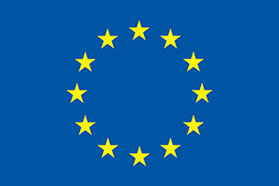NEWS
News about meetings, milestones and from HYPOSO partners.
HYPOSO Project is finished
1 June 2023

Dear reader,
the HYPOSO Project has officially come to an end on 31 May 2023.
This website will therefore not be as active as during the project runtime, however, if important updates from the HYPOSO target countries will reach the people behind this website, these will be published.
Let's remind us that sustainable small hydropower plants (SHP) can be an enabler for more renewable energy integration into the electricity grids. By providing base load and, if operated in the right manner, flexibility services, SHP can contribute to the new era of energy systems facilitating the integration of a lot more volatile renewable energy sources coming from PV and/or wind power.
With small & large hydro, and of course with pumped storage hydropower (PSH), hydropower is the enabler of an energy system on the way to Net Zero.
#WithHydropwer, yes we can!
HYPOSO Final Event - a great final for the HYPOSO Study Tour and the HYPOSO Project
12 May 2023
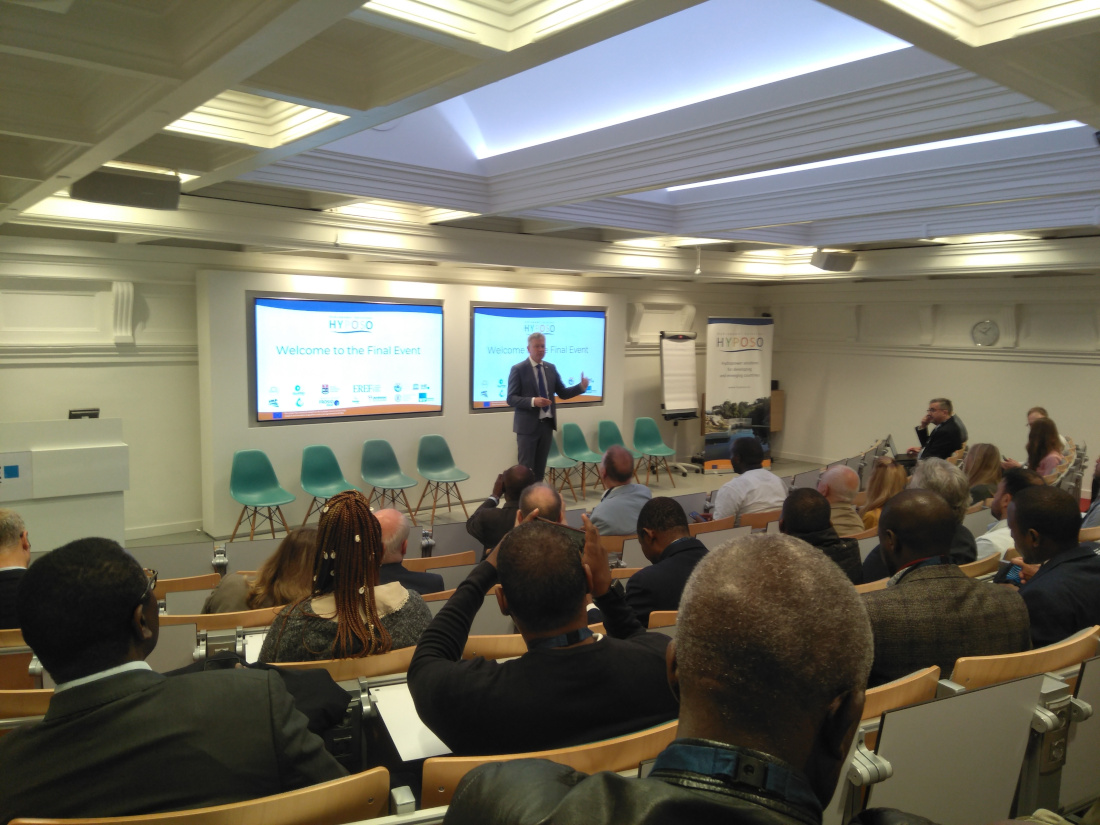
In the last month of the HYPOSO project duration, a HYPOSO Final Event titled “Hydropower solutions for developing and emerging countries – Bringing Africa, Latin America and Europe together” was organised on 12 May 2023 at IHE Delft, to present the HYPOSO project results and discuss the needs for the future of small hydropower in Europe, in the HYPOSO target countries, and in the world.
The event brought together relevant stakeholders from the target countries (political and industrial) and representatives of the European hydropower industry and other stakeholders. It was an opportunity not only to learn about the HYPOSO project results, but also to use the chance of having an international delegation at the venue, stakeholders from the national hydropower sectors from the HYPOSO target countries in Africa (Cameroon and Uganda) and in Latin America (Bolivia, Colombia, and Ecuador), who arrived in Delft after the HYPOSO Study Tour through four European countries.
The agenda was as follows (in brackets are the times of the presentations if you are interested in the talks) :
Welcome and introduction - Miroslav Marence, IHE Delft, Netherlands
About the HYPOSO Project
Ingo Ball, WIP, Germany (00:05:35)
Key note speech
Hélène Chraye, Deputy Director Clean Planet and Head of Unit Clean Energy Transition, DG Research & Innovation, European Commission (00:19:40)
Opportunities for the EU small hydropower sector under the EU Green Deal
Dirk Hendricks, EREF, Belgium (00:36:30)
The HYPOSO Map – a useful tool for academia and the industry
Petras Punys, VDU, Lithuania (00:57:20)
Capacity building – working today on the experts for tomorrow
Miroslav Marence, IHE Delft, Netherlands (01:30:35)
15 potential hydropower sites in five countries – possibilities for corporations
Bernhard Pelikan, Frosio Next, Italy (01:53:50)
Framework conditions for small hydropower – experiences from three continents
Ewa Malicka, TRMEW, Poland (02:27:05)
Panel discussion (02:56:50, not all speakers are visible, yet audible)
In the morning, b2b talks were organised and interested European stakeholders had small stands where they presented themselves in a little exhibition to the international partners. In parallel, the HYPOSO Advisory Board met in the premises of IHE Delft.
This first coming together was concluded with a Gala Dinner in the evening.
We hope that the contacts made will be used to bring forward the hydropower sector in Africa, Europe, and in Latin America.
HYPOSO Study Tour in Europe
11 May 2023
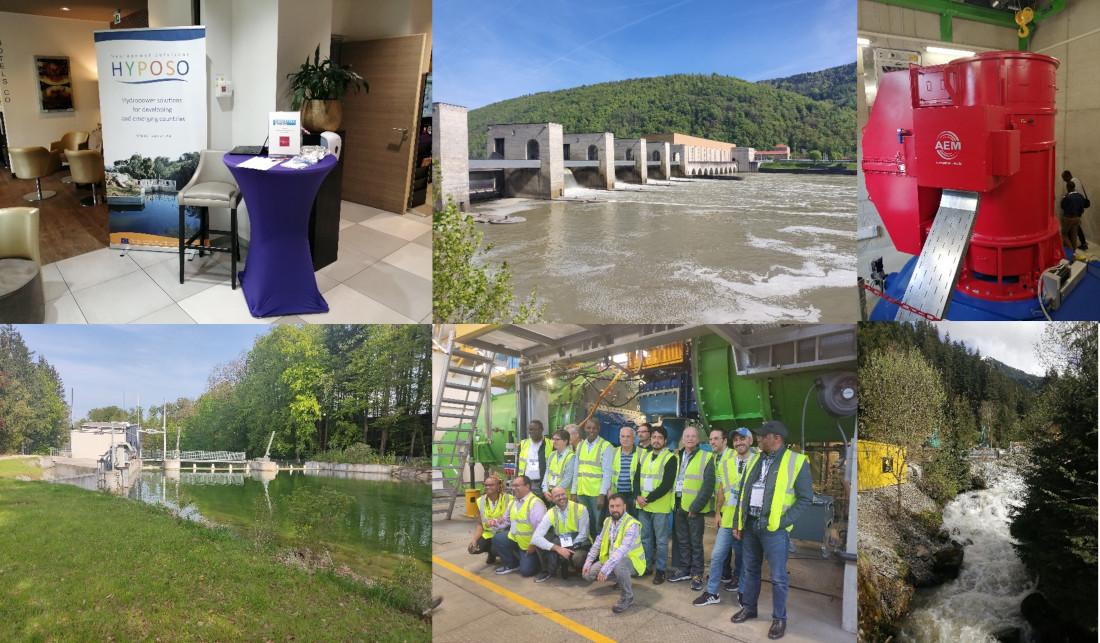
The HYPOSO Study Tour had the aim of bringing together potential business partners from the HYPOSO target countries with the European hydropower industry. It was planned that selected African and Latin American stakeholders, especially project developers, investors and multipliers could visit various European manufacturers, research institutes and reference hydropower plants, to get information on latest European hydropower technologies.
The Study Tour lasted eleven days, from 3 to 13 May, 2023, and took place in four European countries: Germany, Austria, Italy and the Netherlands. Eight site visits at hydropower plants were organised (Jochenstein, Vöcklabruck, Obervellach II, St. Anton, Wiesen, Sellrain, Fotsch, Möhne) as well as nine visits at headquarters or production facilities of hydropower equipment producers (Global Hydro, Voith Hydro, Gugler Water Turbines, Andritz Hydro, Braun Maschinenfabrik, Troyer, Wild Metal, TRM Tiroler Rohre GmbH, Ossberger). The group stayed in nine cities and travelled around 2,500 kilometres. The organisers hosted 24 guests from Cameroon (6 participants), Uganda (5 participants), Bolivia (6 participants), Ecuador (2 participants) and Colombia (5 participants). All of them were directly connected with the hydropower sector in the target countries, in positions of presidents or general directors of hydropower plants operator companies, HYPOSO pilot sites owners, project developers, general managers or project managers, lord mayors, civil engineers and energy planning specialists.
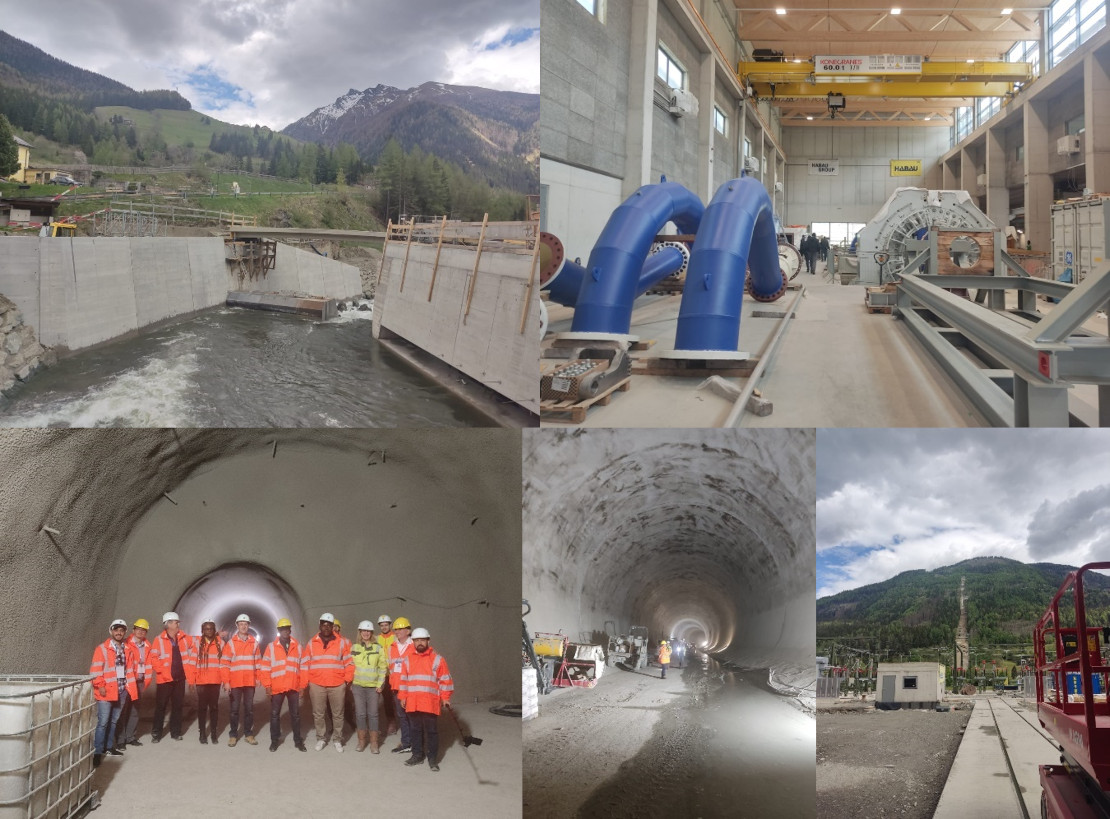
Site visit at Obervellach II hydropower plant
Read the complete report here, and don't miss the chance to watch the HYPOSO Study Tour Video.
The main conclusion from the Study Tour and Final Event shows that the end of the HYPOSO project is the starting point for many interesting activities identified around Latin America and Africa during the project and the beginning of wider cooperation between stakeholders from target countries and European hydropower industry. Moreover, there is clearly noticeable need for international cooperation in order to facilitate the development of hydropower worldwide. Established and maintained business contacts during the HYPOSO Study tour will surely be continued in the future.
The entire tour, as well as individual visits, took place in compliance with the relevant safety rules, thanks to which the trip was completely safe, without any incidents and problems. During the Study Tour various activities allowing participants to spend time in an active and engaging way were organised, enabling learning via participation in company presentations, site visits, discussions, and networking. Time for business meetings and matchmaking was also provided. The organisers were available to the participants throughout the tour, helping to meet the participants' current needs related to participation in the Study Tour.
During the Study Tour there was an interest in organising further study tours for participants from Latin America. Considered were two kinds of study tours. The first one would be an educational tour for representatives of public administration entities, involved in issuing permissions for hydropower plant investments to learn about the best practices in hydropower in Europe. The second type included business tours for representatives of hydropower operators to visit certain hydropower equipment producers, necessary to find the best solutions for their schemes. It shows that the HYPOSO project with its task of the Business Cooperation Study Tour organisation could be replicated in the future due to considerable interest about this kind of knowledge exchange and b2b matchmaking. The results of the HYPOSO Study Tour are satisfactory, the objectives of the trip were fully met and similar projects are expected to continue in the future.
The HYPOSO consortium thanks the organisers a lot. This was a masterpiece of organisation.
HYPOSO - Final Event in Delft, Netherlands
4 May 2023
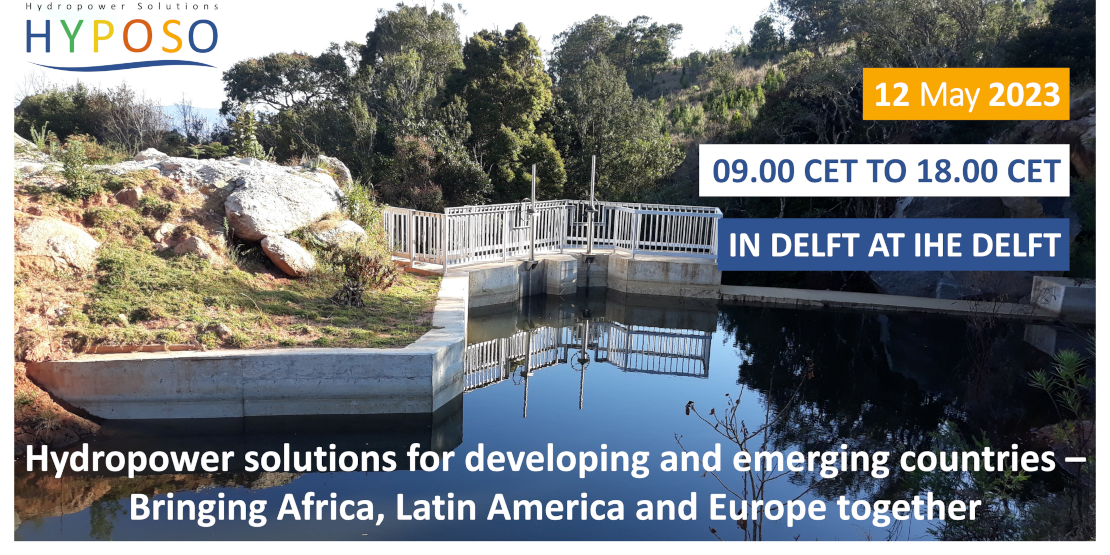
After more than three years, the HYPOSO project will end in May 2023 and the project partners are pleased to invite you to the final event “Hydropower solutions for developing and emerging countries – Bringing Africa, Latin America and Europe together” to present the results of the project and discuss the needs for the future of small hydropower in Europe, in the HYPOSO target countries, and in the world.
This event is an excellent opportunity not only to learn about the HYPOSO project results, but also to use the chance of having an international delegation at the venue, colleagues from the national hydropower sectors from the HYPOSO target countries in Africa and in Latin America, who arrive in Delft after a Study Tour through some European countries.
In the morning, B2B talks will be thus facilitated on demand, and interested European stakeholders can inform us if they want to have a “micro” stand (at a table or high table) where they can present themselves in a little exhibition to the international colleagues.
In parallel, the HYPOSO Advisory Board will meet in the premises of IHE Delft.
This first coming together will be continued in the afternoon with the Final Conference (see agenda below) and concludes with a Gala Dinner in the evening.
We invite you for this international hydropower gathering and we look forward to interesting and good talks with you.
You can register for the Final Event HERE.
Read the full agenda.
HYPOSO Workshop on Framework Conditions for Small Hydropower in Uganda
15 March 2023
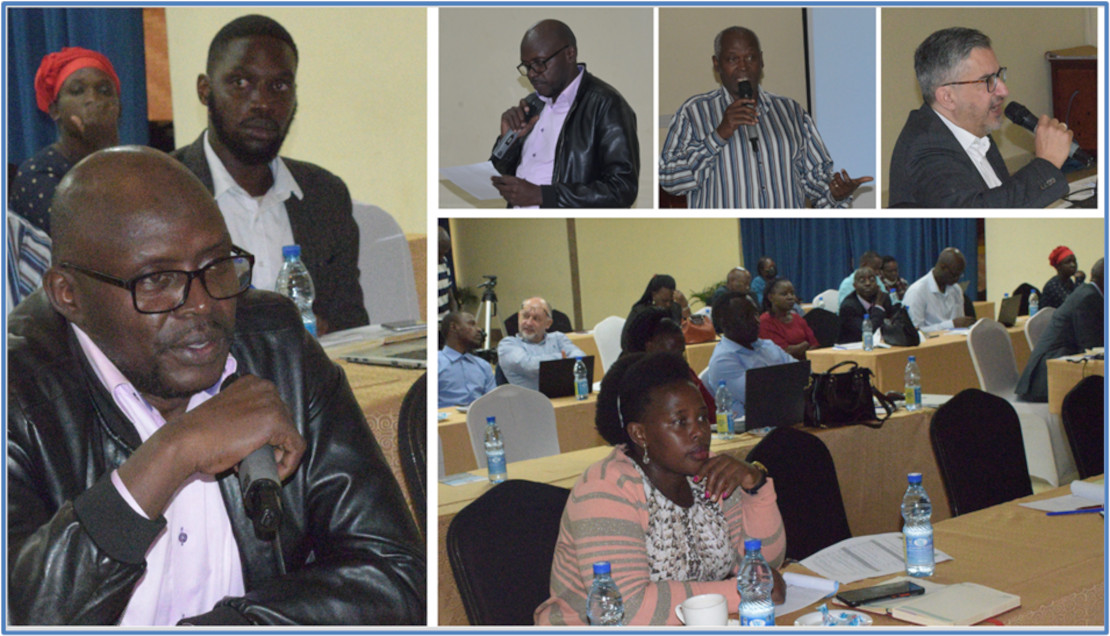
Participants discussing at the Workshop on Small Hydropower Framework Conditions in Uganda
This workshop in Uganda was the last one of five workshops on the framework conditions for small hydropower in the HYPOSO target countries and had a very long story until it really happened. Due to different objectives, it had to be postponed and replanned four times.
The Workshop on Small Hydropower Framework Conditions in Uganda was finally held on 15 March 2023 in Kampala, the capital of Uganda. It was organised by the project partners TRMEW (Poland) and HPAU (Uganda). The workshop, taking place in Kampala’s well-known conference venue - Africana Hotel & Convention Centre, brought together 49 participants ranging from developers, government agencies, private sector actors, participants in the capacity building courses, consumers and the media. Dan Marlone Nabutsabi, the HYPOSO Project Manager in Uganda and Acting Chairman for the Hydro Power Association of Uganda (HPAU) began the workshop by briefly taking the participants through the program of the day. He also informed them that the day also doubled as the World Consumer Rights Day, commemorated on 15 March every year.
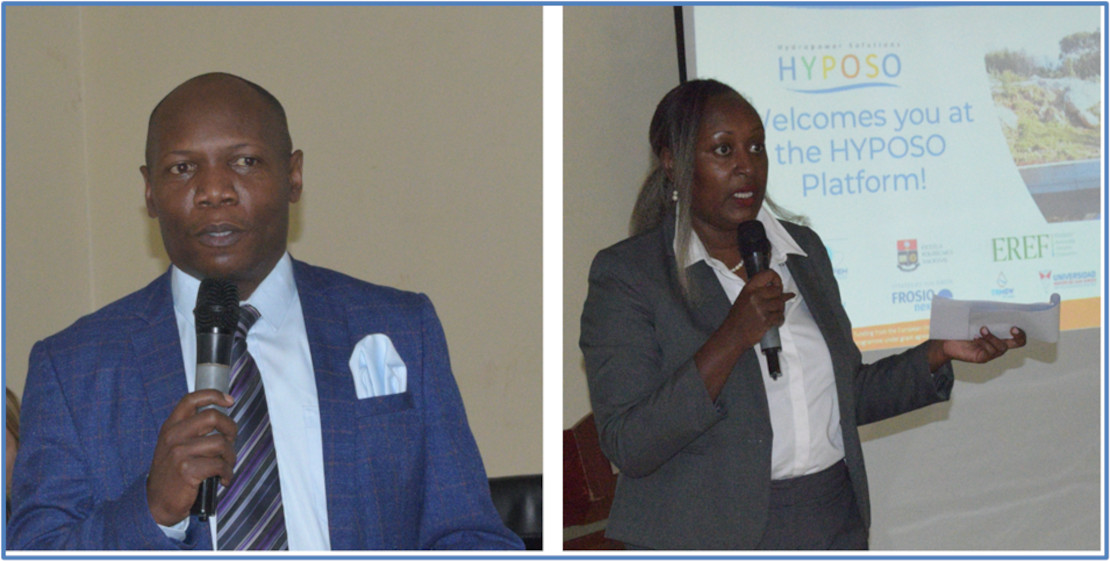
D. Marlone opening the Workshop on Small Hydropower Framework Conditions in Uganda and E. Okwenje giving an overview of small hydropower sector in Uganda and its role in clean energy transition from the perspective of the State Policy
Opening remarks were given by Ms Elizabeth Kaijuka Okwenje from the Ministry of Energy and Mineral Development (MEMD). She gave a brief update on the hydro power status in the country. She expressed the will of the Government of Uganda to encourage private developers, as enshrined in the Energy Policy, National Development Plan III and Vision 2040, to increase access to clean energy. After that Ewa Malicka presented the HYPOSO project and informed about the last HYPOSO activities for Africa - the B2B matchmaking event to be organised at RENEXPO in Salzburg (Austria) on 30 March 2023, and the business cooperation study tour for stakeholders from the target countries to be organised from 3 to 13 May 2023 in Europe. Next, D. Marlone presented about the main outcomes of the analysis of the framework conditions for hydropower in Uganda made within the project together with the Lithuanian project partner VDU. After this, Beatrice Baratti (Frosio Next, Italy) informed the participants about the pre-feasibility studies of three potential sites in Uganda. After that, Gitana Vyčienė (VDU, Lithuania) presented the HYPOSO Map with all its features for its use and a tutorial video. Subsequently, the HYPOSO Platform as an international promotion and partner mapping tool and the HYPOSO handbook were presented by Tasniem Jawaid (EREF, Belgium).
Next, two presenters shared their views about the state of small hydropower in Uganda and its role in transition to clean energy. As mentioned earlier, this day was also the World Consumer Rights Day, whose theme was ‘Clean Energy Transitions.’
Subsequently, E. Okwenje highlighted on the overview of hydropower regarding the state policy. She rerated the fact that government had the will to support the development of small hydropower projects in the country, as one of the ways of increasing access to clean energy.
This was followed by the last two presentations on barriers and experiences in small hydropower plants development from the point of view of the private sector (presented by the HYPOSO pilot project’s developers Mr Benard Mbaine and Mr Jan Pilar from SEBEI HYDRO) and the public sector (presented by Mr David Lubega representing the government agency UEGCL).
After the first part of the workshop the certificates of completion of the Capacity Building Course were awarded to graduates of the course organised for African key stakeholders in January and February 2022 within HYPOSO WP4.
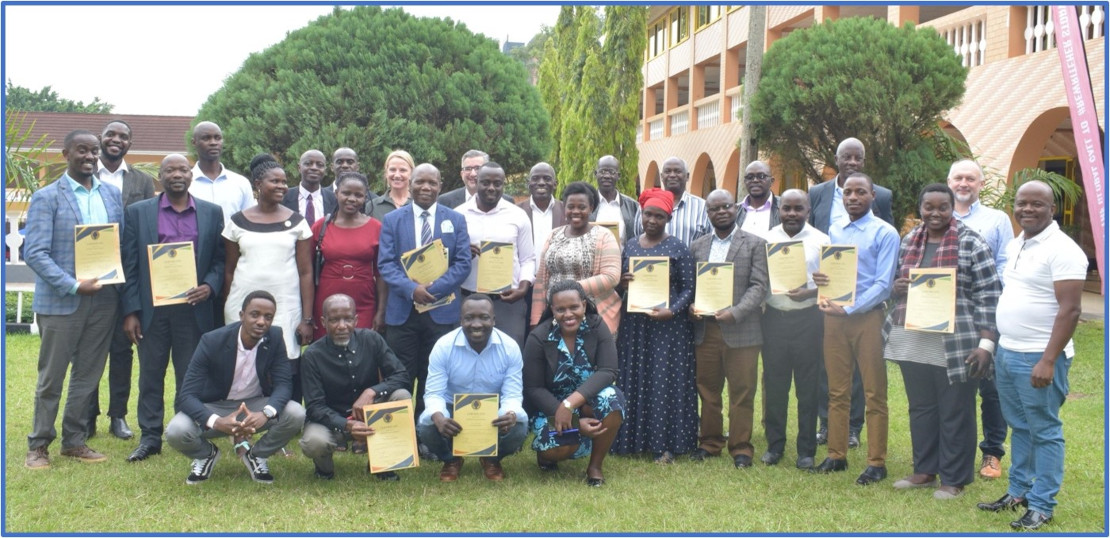
Participants of the Workshop on Small Hydropower Framework Conditions in Uganda
After that a discussion followed. The main issues were highligted by Ewa Malicka:
- The financing issue, in particular the problem of the financial capacity of the Ugandan site owners/developers to meet the financial requirements;
- Need of local expertise on HPP designing;
- Lack of infrastructure to deliver electricity generated in planned SHPPs to the power grid leading to risk of non-bankability of projects;
- Need of outcomes from feasibility studies to be shown to HYPOSO pilot projects developers;
- Scarcity of in-depth information to develop sites identified in the HYPOSO Map and the need of continuation of HYPOSO;
- Prohibition by the electricity regulator to proceed with a few projects at the same time and necessity to complete one project before applying for another;
- The problem of time-consuming procedures to obtain permits while other permits expire and need for regulatory bodies to communicate to each other or need for a one-stop shop for HP development; E. Malicka explained the issue of having a one-stop shop, which she said would help have the different regulatory functions under one roof but is not easy to introduce as the example of the European countries also show.
- Need to engage government to provide solutions to overcome the barrier mentioned above and need for representation of HP developers on government consultative forums as well as the need for representation of government at hydropower sector’s events.
- Lack of knowledge and/or information by applicants to develop hydropower projects and mistakes made by them in applications;
- Impacts of climate change and need to regularly update the HYPOSO Map;
- Need for insurance cover for HP projects; E. Malicka commented that, like in case of the Polish small hydropower association she represents, an insurance programme for SHP owners could be negotiated by an association in Uganda. Each SHP owner can than conclude an insurance contract on secure terms negotiated for members by their association.
After the summary of the workshop, Tasniem Jawaid, Dan Marlone Nabutsabi and Ewa Malicka declared the event closed.
HYPOSO Progress Meeting in Medellín, Colombia
7 March 2023
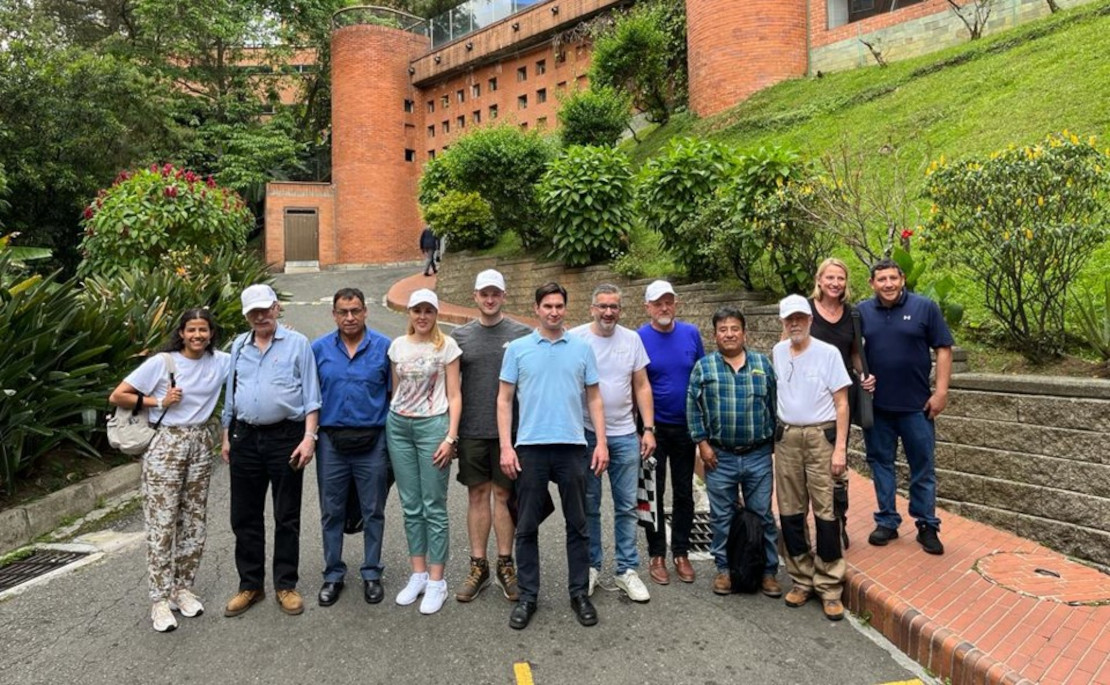
On 2 and 3 March 2023, the fifth Progress Meeting of the HYPOSO Project was held. It was the second last meeting, before the project ends on 31 May 2023. Before the meeting, on 28 February, the Workshop on Framework Conditions for Small Hydropower in Colombia was held, and on 1 March, interested stakeholders were invited to discuss potential business cooperations between potential site providers from Bolivia and Colombia and representatives from the European hydropower industry. This b2b event was organised in a hybrid form.
On 2 March, the regular meeting started with welcome words from Carlos Velasquez (CELAPEH, HYPOSO project partner from Colombia). HYPOSO coordinator Ingo Ball (WIP Renewable Energies) provided then an update about the project status and the last Advisory Board Meeting. Following, Tasniem Jawaid (EREF) informed about the EU hydropower industry cooperation, which is addressed in work package 2 of HYPOSO.
Linas Jurevicius (Lithuania) from VDU gave then an update about the HYPOSO Map, and showed in an animated presentation the newly devoloped features. The HYPOSO Map is technically almost complete, and has been functional already for several months. Miroslave Marence (IHE Delft, Netherlands) reported then about the capacity building courses, which were held in the summer of 2022 in Bolivia and Ecuador, and which are finally assessed. Frosio Next informed then about the nine pre-feasibility studies for the Latin American HYPOSO partner countries. The project partners from Bolivia (UMSS), Ecuador (EPN), and Colombia (CELAPEH) summarized then the experiences of the site visits which happened in summer 2022. Janusz Steller (IMP PAN, POland) presented and discussed then the outlook for the Environmental and Social Impact Assessment (ESIA) which is planned for all pre-feasibility studies. Considering that for smaller hydropower plants, in many cases financing is an issue, Marc Buiting, the financial expert from 1to3 Capital (Netherlands) presented the model, which would enable the financing of sites that are so-called not bankable one, which is often the case in developing countries.
Ewa Malicka (TRMEW, Poland) informed then about the remaining Framework Condition Workshops in Colombia and Uganda. The workshop in Colombia happened two days before the meeting, and the remaining workshop in Uganda was foreseen for 15 March 2023. She informed further about the organisation of the HYPOSO Study Tour which shall start on 3 May 2023. Ingo Ball informed then about the b2b matchmaking events and revealed that it is planned to prepare policy papers that shall be ready for the Final Event on 12 May 2023. He continued the talks informing about the communication activities which are led by WIP.
On 3 March, the consortium used the morning to discuss how the remaining project activities could be implemented. Ingo Ball concluded the meeting with the announcement of the next meeting in Delft, and informed as well about possible follow-up activities for HYPOSO.
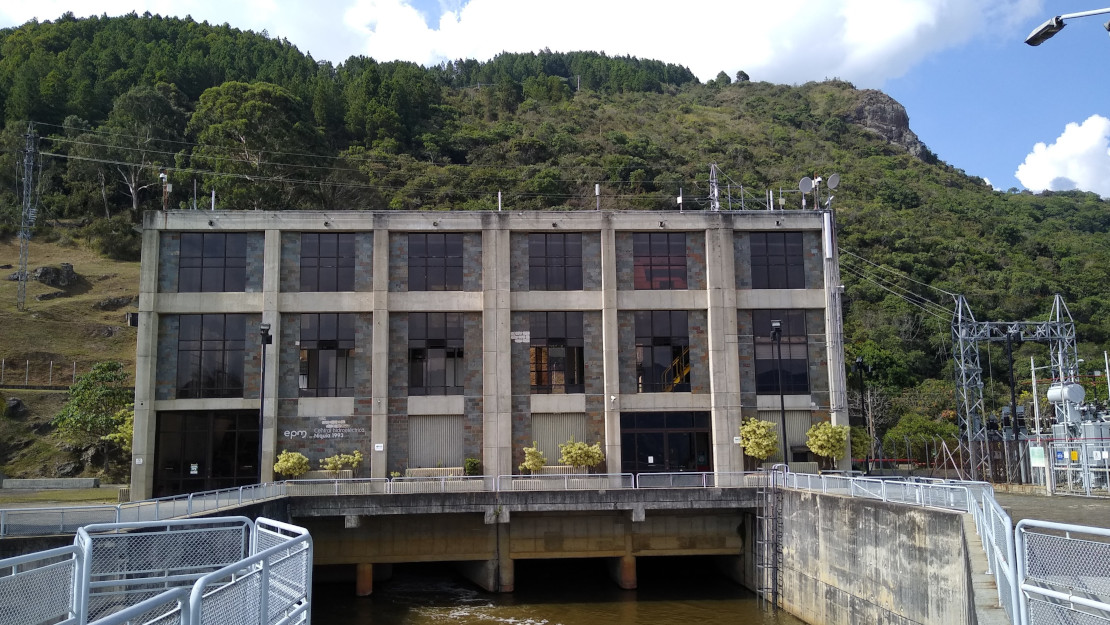
In the afternoon, the consortium had the chance to visit the hydropower plant Niquía. Niquía HPP is part of the "multiple use" of Río Grande and is located in Bello, in the north of the Aburrá Valley. It was commissioned in 1993, with an effective net capacity of 19 MW, corresponding to its first stage, as the physical infrastructure was enabled to install two other generating units in the future, for a total capacity of 57 MW. In 2007, the plant generated 98.8 GWh (gigawatt hours).
The water is fed from the reservoir through a 16.4 kilometre-long tunnel to the powerhouse. After the power generation process at the power plant, it is gravity-fed from the loading tank (located at the outlet of the Niquía power station) to the Manantiales drinking water treatment plant, via a 4.1 kilometre-long pipeline, to be used as water supply for the Aburrá Valley. Manantiales has a current drinking water treatment capacity of 5 m3/s.
HYPOSO Framework Condition Workshop in Colombia
28 February 2023
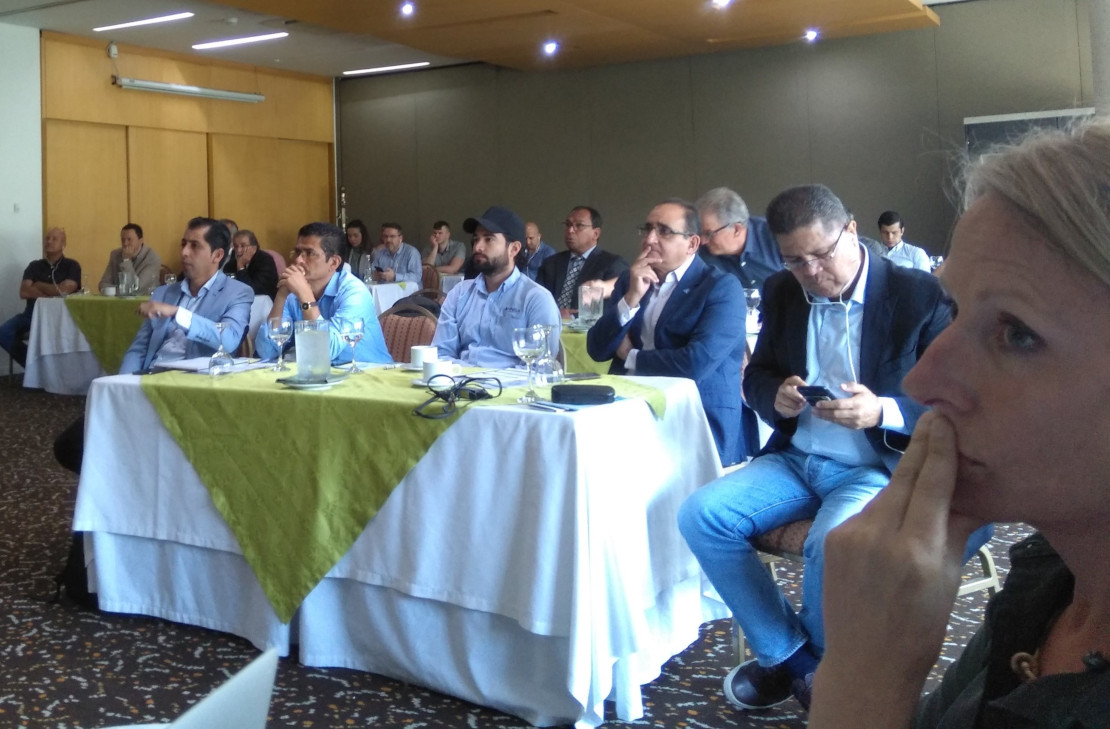
Focused participants of the Workshop on Framework Conditions for Small Hydropower in Colombia in Medellín
On 28 February 2023, the fourth of five HYPOSO Workshops on the Framework Conditions for Small Hydropower took place in Medellín, Colombia. It was organised by the local project partner CELAPEH, together with the local based organisation Sociedad Antioqueña de Ingenieros y Arquitectos – SAI. Altogether, 45 participants gathered to get updates and information about the SHP sector, from political institutions (government, regulatory and environmental authorities), project owners and developers, electric utilities with a SHP portfolio, European manufacturers and suppliers, as well as engineering companies, associations, and consultants.
The agenda was structured to allow for a maximum active participation of the attending stakeholders and was divided into following blocks:
1. Introduction about the HYPOSO Project, including 5 presentations to inform about objectives, the tools developed, the work done and the work to be done
2. Four discussion panels, each one dedicated to issues related to one of above mentioned specific stakeholder groups.
3. A plenary session focused on the barriers to SHP development and recommendations to eliminate or mitigate such barriers.
4. A closure statement from HYPOSO representative (Ewa Malicka)
The Panel blocks allowed for a very intense exchange of useful opinions and information. The panelists of each stakeholder group were requested to answer questions from other stakeholders groups, thus enhancing a better understanding of each others role and activities.
During the plenary session, every participant had the opportunity to make a short comment on a specific issue, achieving a 100% active participation. Each participant also contributed with its knowledge and expertise to a better and more comprehensive understanding of SHP problems and corresponding solutions.
As a result, the main barriers affecting the SHP potential development were identified. The most recurrent of such barriers were:
a. Environmental license procedure is long and demanding (environmental authorities participants acknowledged and mentioned that reforms are under preparation)
b. Regulatory norms were developed for large hydro and are difficult to fulfill by small hydro. Once again, regulatory norms are under revision.
c. As a result from a. and b., pre-feasibility studies for SHP are relatively higher than for LH and many project developers are reluctant to make required pre-investments
d. Social concerns and community’s opposition are growing rapidly, as a consequence of environmental and social impacts of large hydro plants, and communities hardly understand differences between large and small hydropower plants.
e. SHP owners budget for O&M capacity building is in many cases reduced or neglected, and frequent shut downs and damages are the result of poor O&M personnel qualification.
f. Manufacturing and repair facilities for spare parts are scarce, and quite often spare parts must be imported, leading to even longer shut down periods.
g. As a consequence of the above mentioned shutdowns and damages, electricity generation and revenues decrease, in many cases to such a point where capital debt can not be repaid, and power stations are abandoned.
h. Government authorities do not recognize the importance of SHP as a reliable and regular source of clean energy and give preference to other sources, mainly solar, wind and biomass. As a consequence, fiscal incentives and financial resources are mainly allocated to such energy sources.
i. Solar, wind and biomass (also large hydropower) enjoy strong support from powerful lobbies and industries to influence government policies according to their interests. This is not the case of SHP, which is regarded as the ugly duck of the renewable energies family, without a lobby or organization able to bring SHP concerns to the government.
HYPOSO site visits in Latin America
25 August 2022
During July and August 2022, the hydropower experts from the HYPOSO project partners Frosio Next (Italy) and IMP PAN (Poland) visited altogether 9 different potential hydropower sites in Bolivia, Ecuador, and in Colombia, 3 in each of the visited countries. In each of the three countries, they were supported by the local HYPOSO project partners, namely by UMSS (Bolivia), EPN (Ecuador), and CELAPEH (Colombia). During their visits, the HYPOSO experts assessed the available information about the sites at the original places, checked for instance locations for intake, conduction, and powerhouse, and gathered as well information to be considered for the environmental and social impact assessment.
Starting in Bolivia, two sites around La Paz were assessed, and one site close to Cochabamba, where the local HYPOSO project partners from Universidad Mayor de San Símon (UMSS) are located.
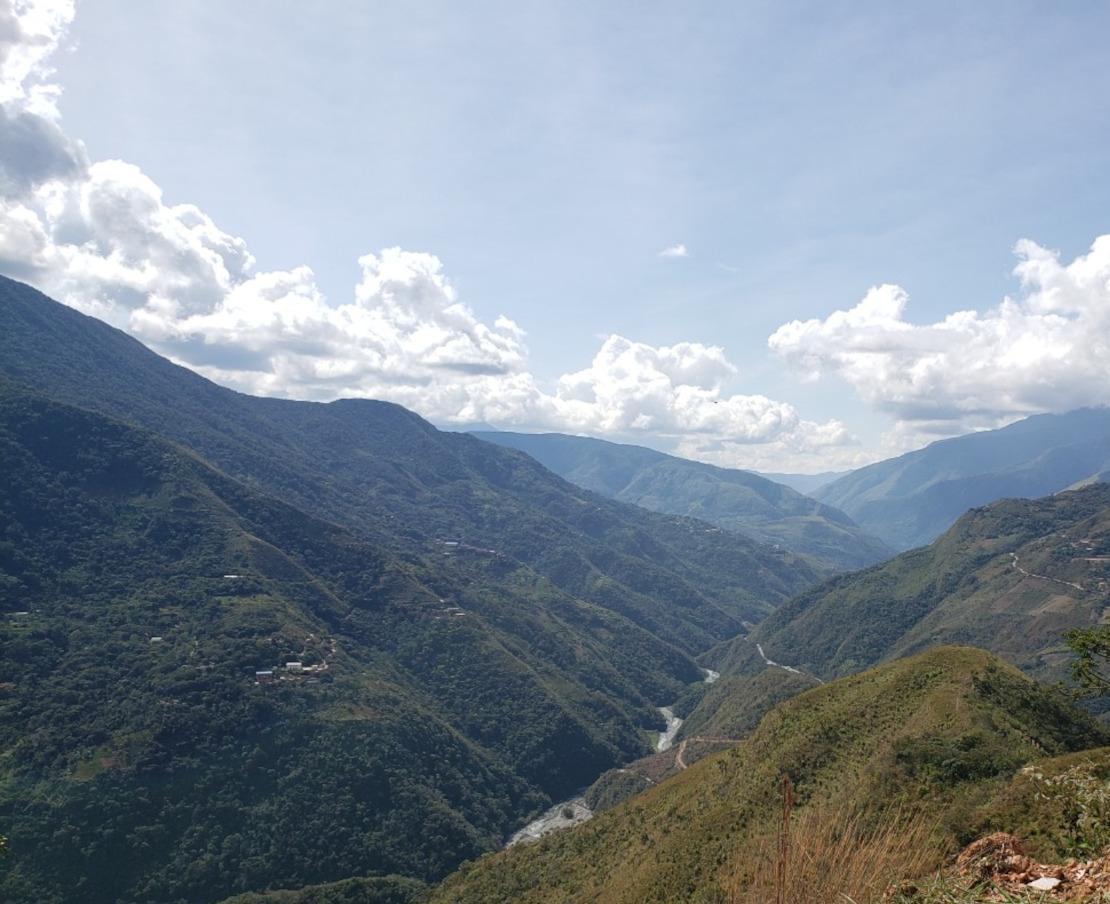
Continuing in Ecuador, there, one potential site is located in the north and another one in the south of Quito, the Ecuadorian capital. The third site is located in the south of Guayaquil.
In the third Latin American partner country Colombia, tow sites are around Medellín, and one site is located around the city of Popayán.
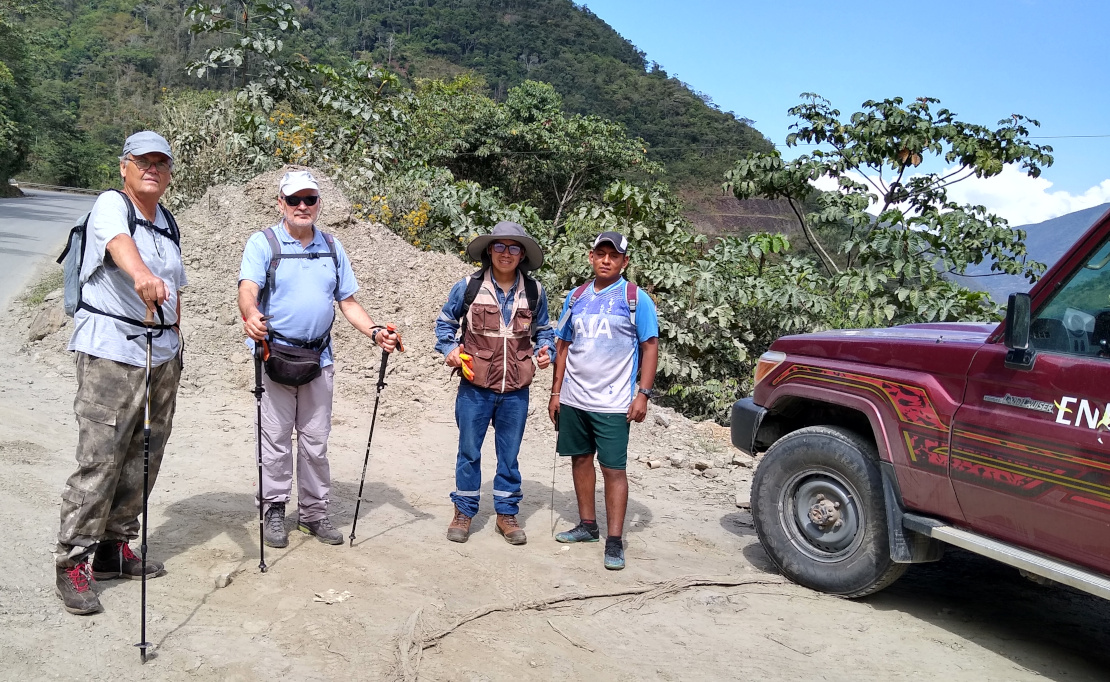
HYPOSO project partners Frosio Next, IMP PAN, and also 1to3 Capital (Netherlands) are currently working on the pre-feasibility studies, the ESIA (environmental and social impact assessment), and also on a dedicated financing recommendation for each site.
HYPOSO Capacity Building Courses in Latin America - Week 2 in Ecuador
16 August 2022
The second week of the Latin American Capacity Building Courses took place from 8 to 15 August 2022 in Quito, Ecuador. They were held in the facilities of Escuela Politécnica Nacional University, in Auditorium of the EARME – CEC building.

The EARME – CEC building at Escuela Politécnica Nacional University in Quito, Ecuador
The courses were given by experts from the sector, namely from the Italian company Frosio Next (Nino Frosio and Bernhard Pelikan), IHE Delft (Shreedhar Maskey and Miroslav Marence), and from the Polish academy IMP PAN (Janusz Steller and Waldek Janicki). Frosio Next shared their experiences when speaking about weirs and water intakes, hydropower systems, operation and maintenance, and gave the participants insights into design training. IHE Delft discussed topics on hydrology and small hydropower projects, and IMP PAN informed the participants about hydraulic units and spoke also about operation and maintenance, and about electrical equipment and lines. Following to the face-to-face courses, the participants were given an online course called Financial Analysis (financial structuring of hydropower assets) which aims at increasing bankable propositions by teaching all elements that are making a credit proposal.

Participants studying during the CBC in Ecuador
After the courses, the participants visited the SHP Palmira Nanegal, which is a 10 MW hydropower plant in the Nanegal Parish, north of Quito. The participants visited there the water intake, open and closed channel section, forebay and powerhouse components.

Participants visiting the forebay of the Palmira Nanegal Hydropower plant

CBC Participants visiting the powerhouse of the Palmira Nanegal Hydropower plant
In addition to the activities developed in the courses there was a visit to the Center for Water Resources Research and Studies of EPN – CIERHI where the participants were able to find out about the activities of the Center and the current physical models under development.

CIERHI – EPN internal facilities and participants visit
HYPOSO meets Colombian hydro stakeholders in Medellin
6 August 2022
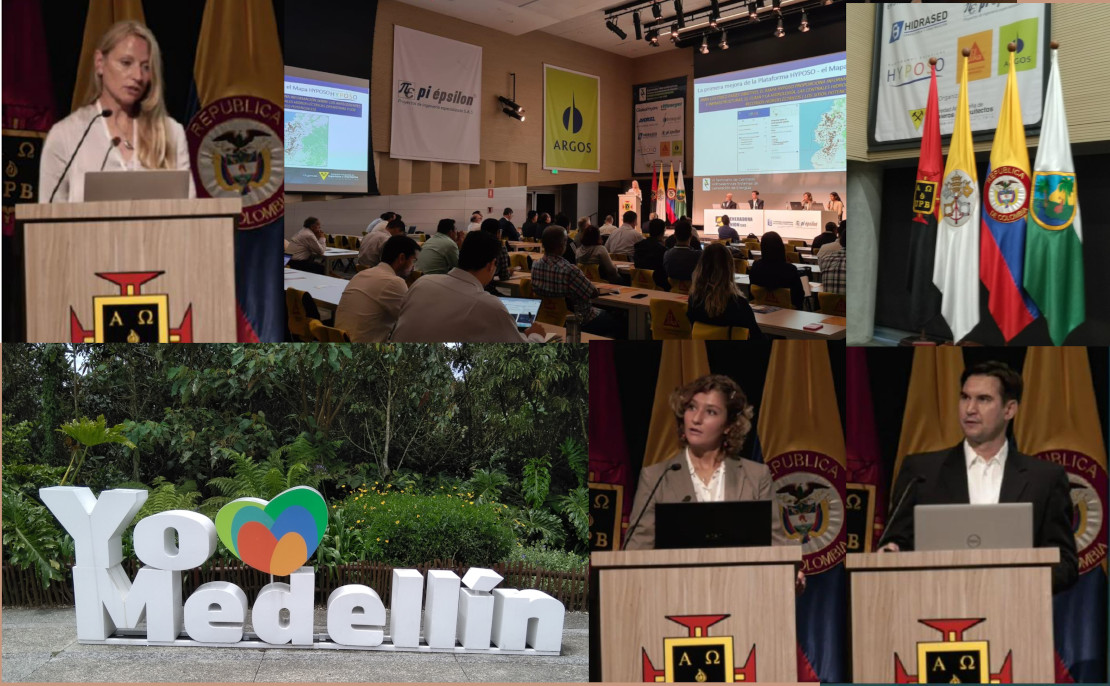
Impressions of the SAI event in Medellin
From 3 to 5 August 2022, the renowned Colombian society SAI (Sociedad Antioqueña de Ingenieros y Arquitectos - Antioqueña Society of Engineers and Architects, based in Medellín, the capital of Department Antioquia), organized the VI Seminario de Centrales Hidroeléctricas (Seminar on Hydroelectric Plants), which in fact could be called a little conference.
Aim of this event was to present different points of view so that the decisions of the electricity sector are taken correctly and allow to build the necessary energy security and independence that Colombia needs in its future. The event attracted more than 400 participants (on site and virtual), and was acompanied by a little exhibition, where the participants met during the breaks to network, and continue the discussions from the sessions.
The HYPOSO project had the possibility to be presented, thanks to the Colombian project partner CELAPEH.
On 4 August 2022, in a morning session, four presentations were given to infrom the participants about the project.

Ingo Ball (WIP, Germany) during his talk
After welcoming words of Carlos Velasquez (CELAPEH), HYPOSO Coordinator Ingo Ball (WIP Renewable Energies) gave an overview about the project and the status quo of its activities.
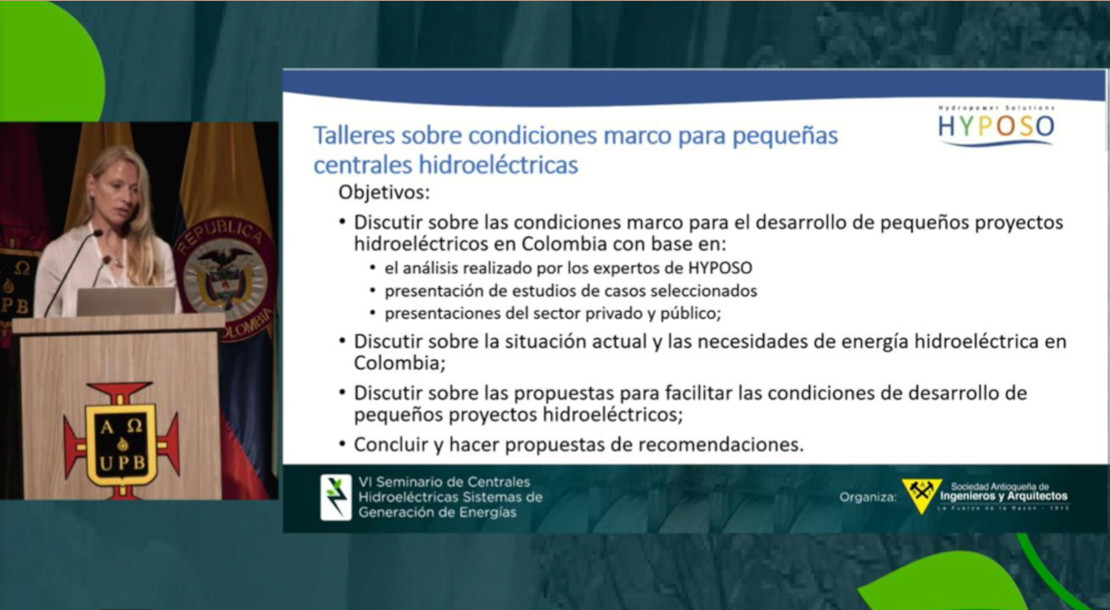
Ewa Malicka (TRMEW, Poland) informing about the HYPOSO tools
Then, Ewa Malicka, HYPOSO project partner (TRMEW) and President of the Polish Small Hydro Association, spoke about how to bring together Colombian and European small hydropower stakeholders. She presented therefore the tools provided in the HYPOSO project, the HYPOSO Platform, the Workshops on Small Hydropower Framework Conditions, and the Business cooperation study tour for African and Latin American stakeholders, which is planned at the end of the HYPOSO project. She was supported by Laura Velasquez (CELAPEH) who translated the talk into Spanish.
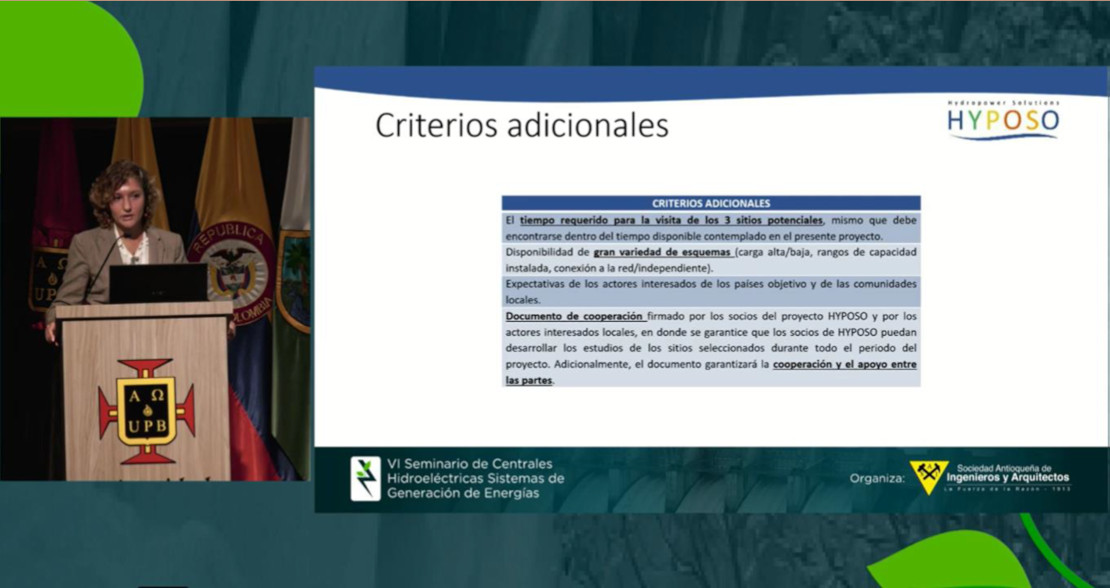
Beatrice Baratti (Frosio Next, Italy) presenting the business case methodology
Following, Beatrice Baratti, gave insights how the 15 business cases within HYPOSO were selected, and which steps are being considered during the study development, as well as in the assessment of the einvironmental and socioeconomic impact of the studied projects. She mentioned concluding that the economical viability and different opportunities to finance these projects are evaluated based on the findings of the pre-feasibility studies.
 '
'
Carlos Velazquez (CELAPEH) during his presentation
Finishing, Carlos Velasquez (CELAPEH), gave a presentation how CELAPEH is contributing to the HYPOSO project in Colombia, explaining the different tasks that are being worked on. He finished his talk to inform the participants about CELAPEH's mission, ending with a call to create a dedicated Colombian Association of Actors and Producers of small hydropower.
After the presentations, the HYPOSO colleagues provided additional information to participants in a short Q&A session.
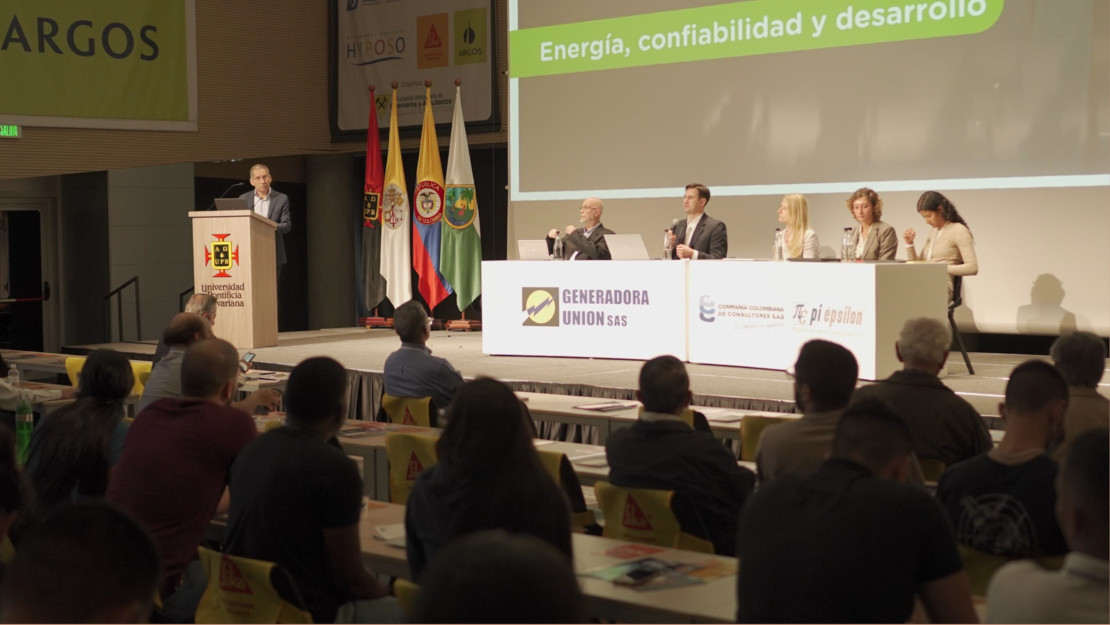
HYPOSO representatives answering questions after the session
HYPOSO Workshop on Small Hydropower Framework Conditions (WFC) in Ecuador
26 July 2022

Antonio Villagómez, Sub-Manager of Hydroelectricity at EPMAPS presenting at the workshop
The third (of five) HYPOSO Workshop on Framework Conditions for Small Hydropower was held on 26 July 2022 at the Hemicycle of Escuela Politecnica Nacional (EPN) in Quito, Ecuador. It was organised by the project partners TRMEW (Poland) and EPN (Ecuador) and could welcome 47 participants on site. Ms Patricia Lorena Haro, Professor at EPN opened the event and welcomed the guests, and after that Ewa Malicka, President of the Polish Small Hydro Association had a welcome speech, after which she presented the information on the HYPOSO project as well as the objectives of the workshop. After the introduction, Luis Rios presented the outcomes of the analysis of the framework conditions for hydropower in Ecuador made within the project by the Lithuanian HYPOSO project partner VDU. Subsequently, Nino Frosio (Frosio Next, Italy) presented the three selected case studies, which were just about to be visited by the project experts in coming days. He pointed out the potential barriers these projects can encounter while being developed.
After this, Ms Fernanda Jara, Director of Expansion and Transmission of Power Generation at the Ministry of Energy and Non-Renewable Natural Resources gave an overview of the small hydropower sector in Ecuador from the perspective of the State Policy.
Two next speakers, Mr Alexandre Barahona, General Manager at CBS Ingeniería and Mr Antonio Villagómez, Sub-Manager of Hydroelectricity at EPMAPS – Quito, delivered presentations on barriers and experiences in the SHP plants development respectively from the point of view of private and public sector.

The invited speakers of the HYPOSO Workshop on Framework Conditions
It was followed by the most important part of the workshop, i.e., the discussion, moderated by Prof. Bernhard Pelikan (Frosio Next) on the actual situation and needs for hydropower in Ecuador as well as on the ideas how these needs can be met and how the development of small hydro projects can be facilitated. The views and ideas were discussed together with representatives of the two Ministries (Energy and Non-Renewable Natural Resources (MEM) as well as the Ministry of the Environment (MAAE), public and private companies, scholars, and other stakeholders such as: CBS Ingeneria y CBS Energy, EPMAPS, MAATEARCERNNR, IIGE, Hidroequinoccio EP, Constructora Nacional, EEQ, CIE, Fundacion Cice, EPN, and the HYPOSO experts.

Discussing the needs for better framework conditions for small hydropower
The matters indicated by the participants included the need of severe improvement of the legislation with regards to regulations on small hydropower including more simple approach towards this kind of projects and a clear distinction between small and large hydro. Another issue indicated by participants was the need to improve the feasibility of small hydro projects which seemed to be closely related to better access to information on projects development procedures. In this respect the recommendation of creating a small hydropower association in Ecuador was formulated. Other points mentioned within the presentations and then the discussion included the need of a stability of tariffs, at least for projects payback period, and the need to improve the allocation of the existing “green credits”. Finally, the significance of energy recuperation combining portable and wastewater systems with hydropower was underlined.
The main points of the discussion were then summarized by Bernhard Pelikan, and the participants expressed the need and will to formulate adequate recommendations to be communicated to the respective policy makers and authorities.
In the end of the workshop the outcomes of the HYPOSO project - the HYPOSO Map and the HYPOSO Platform - were presented to the participants as tools made to increase a number of investments in sustainable projects in target countries, to facilitate communication between stakeholders in Europe and Latin America as well as to stimulate the market uptake of EU technologies there.

Speakers and some participants after the workshop
HYPOSO Workshop on Small Hydropower Framework Conditions (WFC) in Bolivia
22 July 2022
Following the first WFC in Cameroon early this year, in July 2022, two further WFC were organized in the HYPOSO target countries Bolivia and Ecuador. The first HYPOSO WFC in Latin America was organized by the Bolivian HYPOSO project partners from Universidad Mayor de San Simón (UMSS), together with Ewa Malicka (TRMEW, Poland), who besides being the HYPOSO project partner responsible for these workshops is also President of the Polish Small Hydropower Association.
On 22 July 2022, the WFC for Bolivia was held as live event at UMSS in Cochabamba. The event was also broadcasted via internet so that more stakeholders could participate and have their say. Altogether, 55 (19 on-site) participants contributed to the workshop.
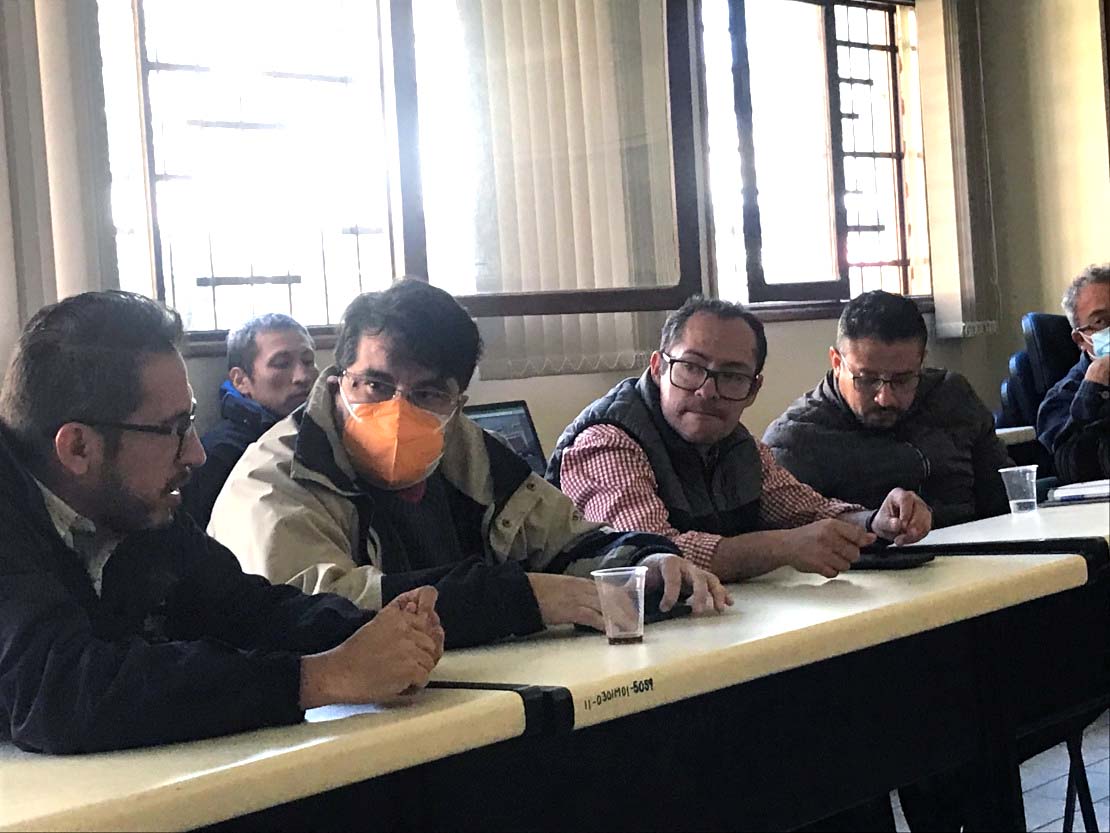
Focused participants of the workshop
The agenda included general information on the HYPOSO project, a presentation of the framework conditions for hydropower in Bolivia based on the outcomes of the HYPOSO framework analysis, and a presentation of 3 case studies in Bolivia and potential barriers for the development of these projects. The program continued with a discussion on recommendations for Bolivia to facilitate national investment - friendly climates for hydropower based on the presented case studies and outcomes of the framework analysis.
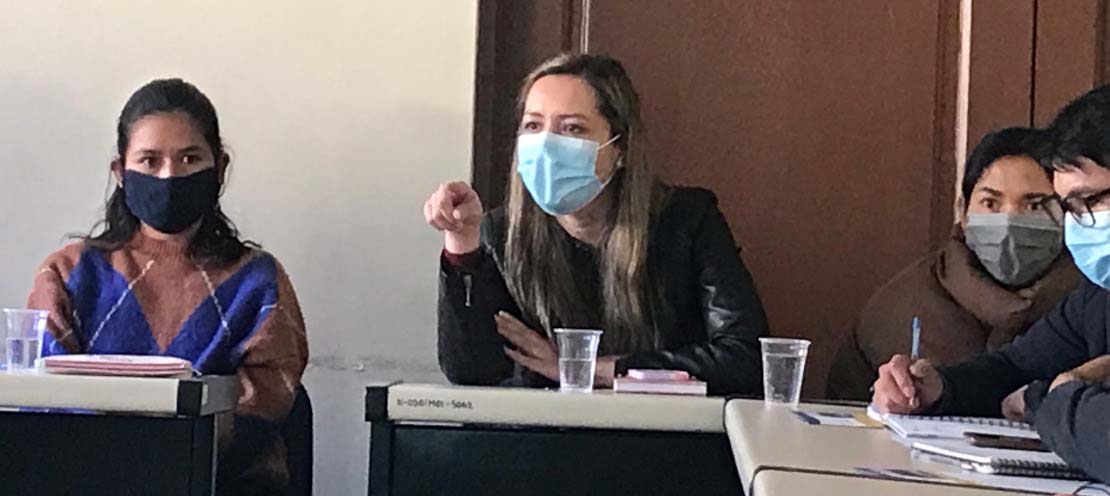
Lively discussion during the workshop
After summarising the discussion and recommendations, the event concluded with a presentation of the HYPOSO Map, which helps to identify potential (small) hydropower sites in Bolivia, and informs about several other relevant issues for hydropower professionals. Finishing, the participants were invited to participate in the HYPOSO Platform, to establish business contacts with the European SHP industry.
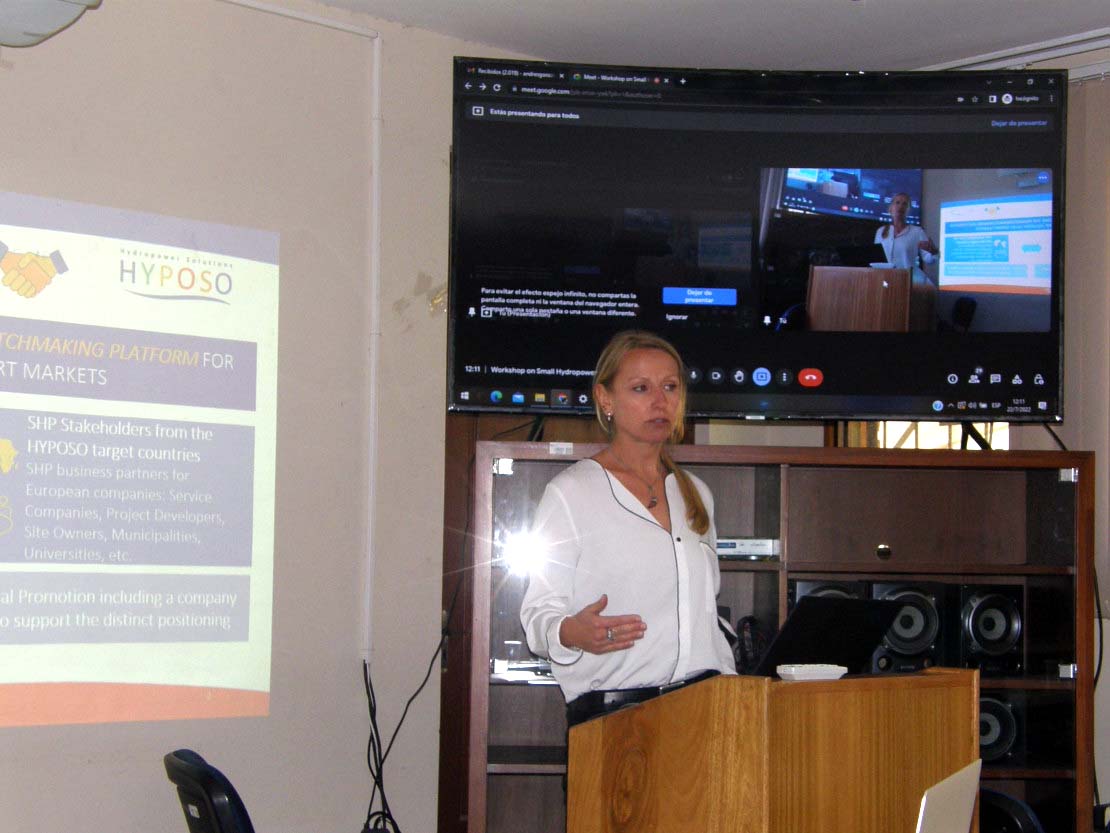
Ewa Malicka (TRMEW) presenting the HYPOSO Platform
The main conclusions of the WFC for Bolivia were:
- Bolivia has some gaps in its laws regarding the small hydropower plants and participation of private institutions in the sector.
- The HYPOSO Platform is a useful tool for Bolivian stakeholders; ENDE (Empresa Nacional de Electricidad - National Electricity Enterprise) Corani and ENDE Corporacion are interested in this application, due to the fact they will need to contact companies for equipment supply. Also the representatives of private companies showed interest since they want to represent equipment offers in Bolivia.
- The study cases in Bolivia are of interest for the participating ENDEs. They asked about the timing (when project studies will be available) and about funding possibilities for these projects.
- Some local researchers from UMSS are also interested in the HYPOSO Map, especially about the possibility of downloading the different layers from the HYPOSO Map.
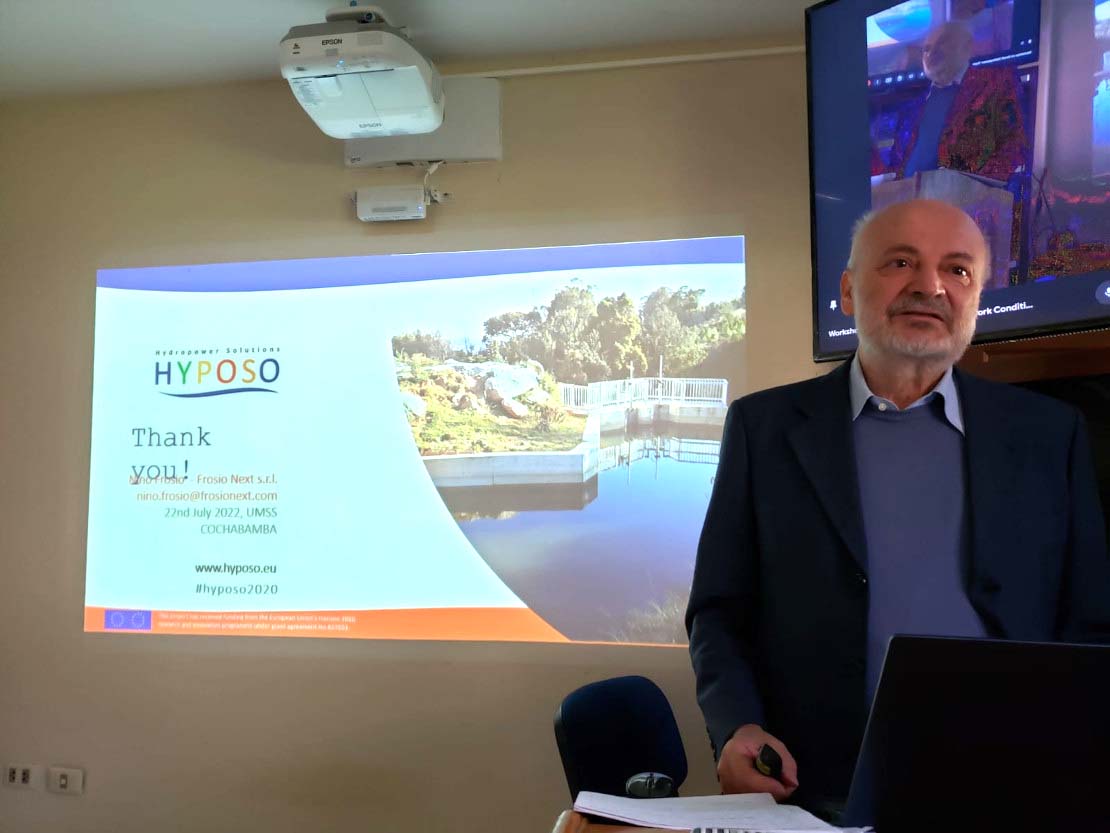
Nino Frosio (Frosio Next, Italy), thanked the participants after his talk
HYPOSO Capacity Building Courses in Latin America - Week 1 in Bolivia
11 July 2022
From 4 to 10 July 2022, the first week of the HYPOSO Capacity Building Courses (CBC) in Latin America was held in the premises of Universidad Mayor de San Simón in Cochabamba, Bolivia.
The week in Bolivia was organized over 7 days and included 5 days of lectures and 2 days of site visits to make use of what they have learnt in the course. The lectures were given by altogether six different lecturers. Four professors from IHE Delft, and two professors from Vytauto Didžiojo Universitetas (VDU). From IHE Delft, Miroslav Marence (also the leader of the Capacity Building work package) informed about the basics of hydropower exploitation, hydropower systems, dams and storage basins, power waterways, and hydraulic designs, Shreedhar Maskey informed about hydrology, Alessandro Cattapan gave important insights about hydrology, and Angeles Mendoza-Sammet informed about related environmental and social aspects. From the Lithuanian project partner VDU, the professors Petras Punys and Gitana Vyčienė gave lectures about GIS & HP potential and computer based tools for hydropower plants.

Participants following Miro Marence and the course
Altogether 17 selected participants could either update their knowledge or get new inputs around important aspects of (small) hydropower.

CBC participants at the Corani hydropower system
After the five days of lectures, over two days, the participants visited the cascade hydropower system Corani.
Last Project Developer Workshops held with stakeholders from Bolivia and Colombia
16 May 2022
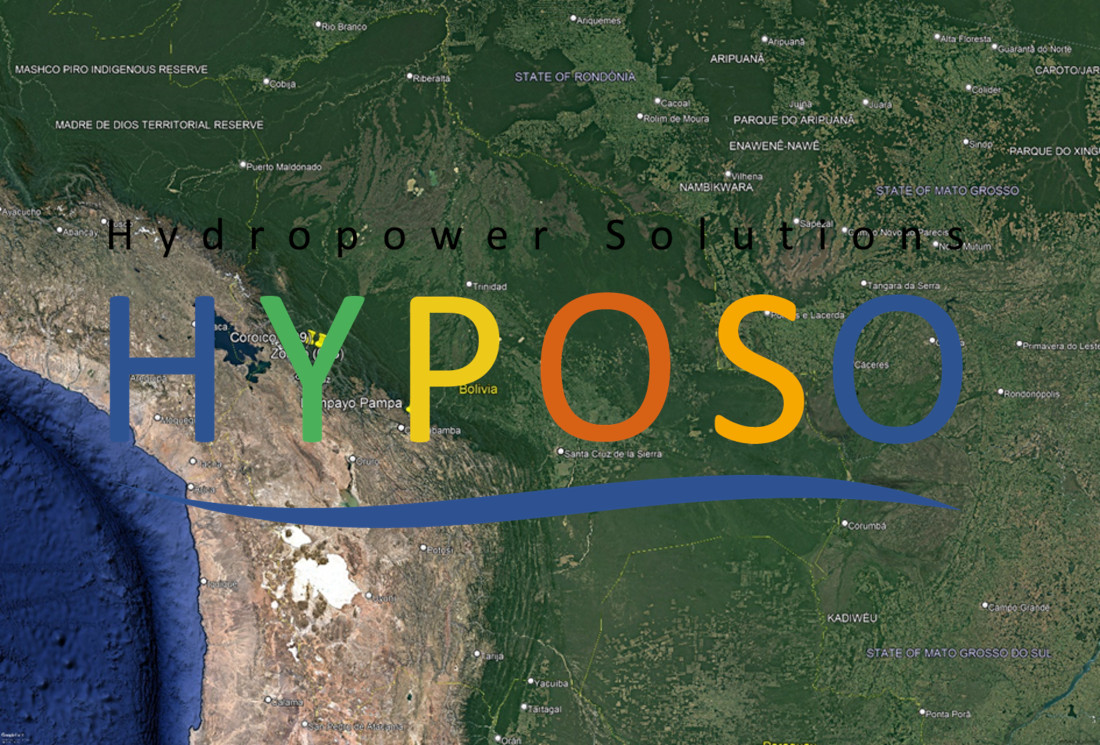
On 16 March 2022 and on 13 May 2022, HYPOSO project partner Frosio Next organised the last two online workshops to select the best potential hydropower sites that shall be investigated within the project in Bolivia and Colombia.
At the first workshop for Bolivia, on 16 March 2022, local HYPOSO project partner Universidad Mayor de San Simón (UMSS) managed to welcome stakeholders from the Ministry of Oil and Energy (ME), members of the Ministry of Water and Environment (MMAYA), members of the National Agency of Energy Distribution (CNDC), members of the national electricity company (ENDE-CORANI and ENDE-CORPORACION), and researchers of UMSS (Universidad Mayor de San Simon).
The second and last Project Developer Workshop was oragnised on 13 May 2022 for Colombia. Among the Colombian stakeholders which attended the webinar, there were members of the National Planning Authority - Energy and Mining (UPME), members of the Environmental Regional Authority (CRC), equipment manufacturers and suppliers and project developers.
At both workshops, Beatrice Baratti from Frosio Next presented the pre-selection of 10 potential hydropower sites in Bolivia and Colombia, out of which 3 sites each are selected to carry out business case studies and make the sites ready for explorance. The discussions were very professional and interesting and support the achievement of the HYPOSO objectives.
The HYPOSO consortium thanks the participating stakeholders and the local partners.
HYPOSO finally live at HYDRO 2022
3 May 2022
After two times in a row, when the planned live session of HYPOSO had to be held virtually or was completely postponed, on 26 April 2022, it was finally time. HYPOSO was given a full afternoon to present its goals and already achieved results to around 80 interested participants. A big thanks goes to Aqua Media and other organizers and supporters of the HYDRO conference. It was a very well organised event, and it was so good to see many colleagues in presence again after a long time.

During the session, opportunities for the European industry to support the development of the small hydropower sector in Africa and Latin America were presented and discussed as they constitute the core of the HYPOSO project. The speakers presented the findings and results of this project achieved so far, including the analysis of small hydropower framework conditions and potential in target countries (i.e. Cameroon, Uganda, Ecuador, Bolivia, and Colombia), identification of potential small hydro sites (a HYPOSO Map) in these countries, and the pilot projects selected there for which the pre-feasibility studies are being developed. They also shared their experience on knowledge and capacity building activities already carried out in Cameroon and Uganda. Finally, a special emphasis was placed on the HYPOSO Platform and the promotion opportunities it provides for the European small hydropower industry.
The presentations and the discussion led to a conclusion that some uncertainty may arise while planning investments in African or Latin American countries. The problem of finding reliable and professional partners there is often raised. But while developing the HYPOSO project this turned out to be a false belief as reliable local partners have been found and the examples of their knowledge and engagement was presented. But still the need to enlarge the number of experienced hydropower experts in the regions being discussed remains an important issue. The proof for this statement could be found during the capacity building courses led in Cameroon and Uganda which raised extreme interest of participants. But even if too little number of hydropower experts can be qualified as a disadvantage regarding investments in Africa and Latin America there are many advantages which can compensate this. The most important one is the hydropower potential which, unlike in Europe, is still available in Africa and Latin America and, what’s more, there is a strong willingness to exploit it even close to nature protected areas. Other conclusions referred to the problem of lack of governmental support for hydropower development in some countries of the discussed regions (e.g. Uganda) and, last but not least, the business opportunities the HYPOSO project, and in particular the HYPOSO Platform, provides for the representatives of European equipment and service providers.
Following was the agenda of the HYPOSO session:
1 - Hydropower solutions for developing and emerging countries: Updates from the HYPOSO project - I. Ball and D. Rutz, WIP Renewable Energies, Germany
2 - Exploring Uganda’s small hydro development - D. Malone Nabutsabi, Hydropower Association of Uganda Ltd (HPAU), Uganda
3 - Ongoing evolution of small hydropower and framework conditions in Cameroon - J. Kenfack, Solarhydrowatt (SHW), Cameroon
4 - Hydropower potential and development opportunities in Colombia - C. Velasquez, CELAPEH, Colombia
5 - Framework conditions of SHP development in Ecuador - V. Minaya Maldonado, Escuela Politecnica Nacional (EPN), Ecuador
6 - Framework conditions for SHP development in Bolivia - V.A. Gonzales Amaya and F.A. Ledezma Perizza, Universidad Mayor de San Simon, Bolivia
7 - Hydropower potential sites determination and benefits of small hydropower systems using irrigation infrastructure applied to national electrification within HYPOSO - F.A. Ledezma Perizza and V.A. Gonzales Amaya, Universidad Mayor de San Simón, Bolivia
8 - The HYPOSO Map: Identification of potential small hydropower sites in Africa and Latinb America - P. Punys A. Dumbrauskas, G. Vyčienė and L. Jurevičius, Vytautas Magnus University, Lithuania; A. Balčiūnas, Vilnius University, Lithuania
9 - Pilot projects: Justification for selection, challenges and next steps - B. Baratti, N. Frosio and L.L. Papetti, Frosio Next S.r.l., Italy; B. Pelikan, Austria
10 - Knowledge and capacity development in the hydropower sector: Course organization and implementation - M. Marence, IHE Delft, The Netherlands; D. Marlone, Hydro Power Association of Uganda Ltd; J. Kenfack, University of Yaounde I and Solar Hydrowatt Ltd, Cameroon
11 - Showcasing and promoting the European small hydropower industry - T. Jawaid and D. Hendricks, European Renewable Energies Federation (EREF), Belgium
The HYPOSO consortium used the occasion as well to inform stakeholders from the hydro sector which were present at the exhibition about the possibility to register their companies at the HYPOSO Platform to be visible for future business between Europe, Africa, and Latin America.
Progress meeting in Lithuania heralds the final phase of the HYPOSO project
30 March 2022
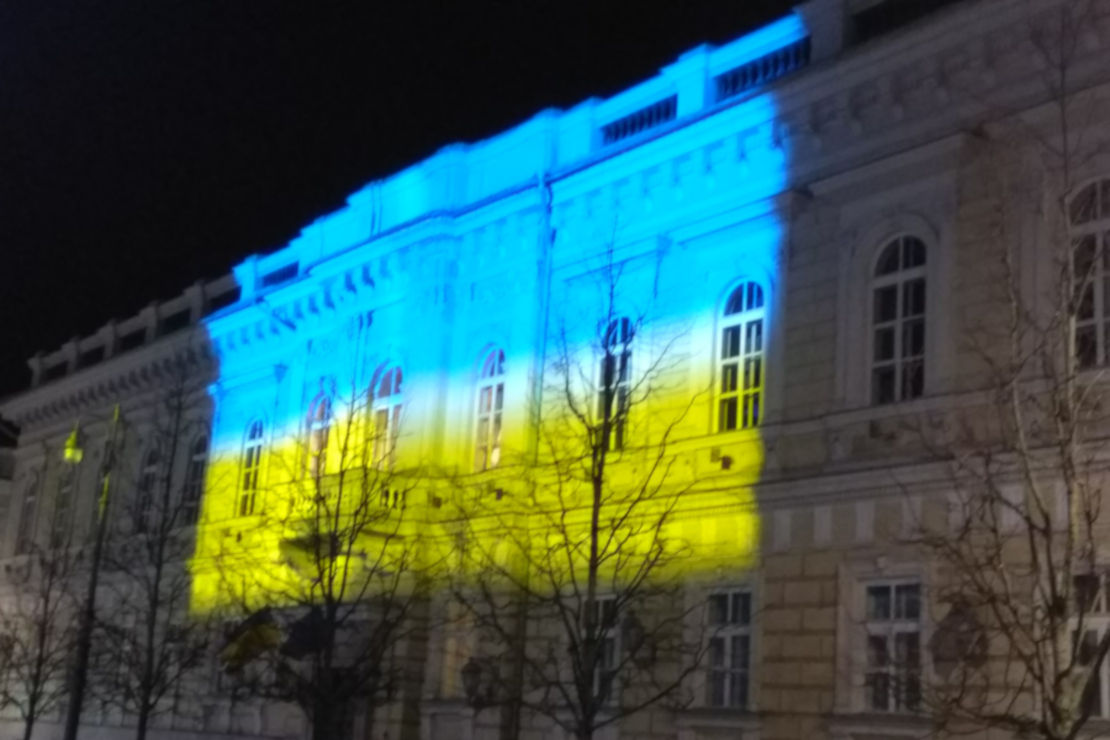
The political situation of March 2022 was visible in many places in Vilnius, the solidarity shown by Lithuanians was a great sign of humanity
On 24 and 25 March 2022, the HYPOSO consortium met again in person to discuss updates and upcoming tasks of the project. The meeting was excellently organized by the Lithuanian HYPOSO partners from VDU (Vytauto Didžiojo universitetas - Vytautas Magnus University), and included one and a half meeting days and site visits after the working meeting, when Pabrade SHP and the historical Liubavas water mill were visited by the consortium.
The meeting started classically with an organisational overview, and an overview about the European hydro stakeholder involvement. The restart of live events is naturally of great importance for the HYPOSO project, so that direct contacts can be made and the project and its opportunities can be dissemninated. A major step could be celebrated during the meeting as well, the HYPOSO Map was published within the HYPOSO Platform. Currently still being the beta version, the HYPOSO Map was again discussed and pending steps were agreed upon. Updates were given as well about the first set of capacity building courses for our African partner countries Cameroon and Uganda, and the first framework condition workshop in Cameroon.
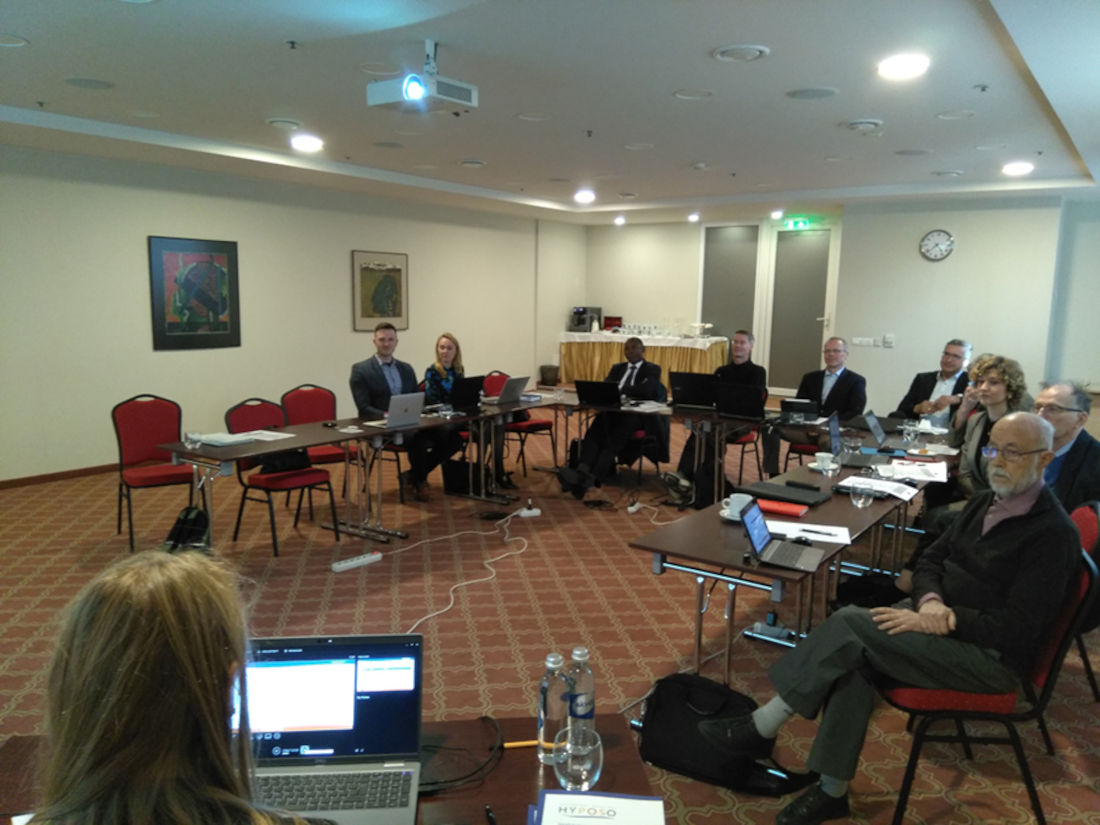
Impression from the working meeting
Partners from Frosio Next and IMP PAN could report about the site visits of the African potential hydropower sites, that will be evaluated and prepared until a pre-feasibility study for each site. For the sites in Uganda, moredetails could be provided, and for the sites in Cameroon, a report was given, not only by Frosio Next, but also from project partner SOLARHYDROWATT (Cameroon), who gave an update about the events that happened in his country last January/February. The financial experts from 1to3 (Netherlands) provided first information about needed selling prizes and possibilities how to involve investors into HYPOSO. The meeting was concluded with a discussion about the organisation of framework condition workshops and other events to be involved in, as well as the plan for the final study tour. The next project meeting will probably be held in Uganda, in July/August 2022.

Overview of Pabrade SHP (315 kW)
The visits of Pabrade SHP (315 kW capacity installed) and the historical Liubavas water mill (20 kW by an over 100 years old turbine from Sweden) on the second day of the project meeting was surely interesting for all participants. Liubavas water mill is the only watermill in Lithuania that contains completely restored equipment. Several technological processes that occurred there were investigated and demonstrated: from grain, wood and metal processing, to mill and electricity production. HYPOSO likes to thank hosts from Pabrade SHP and Liubavas water mill for the invitation and the very informative tours.
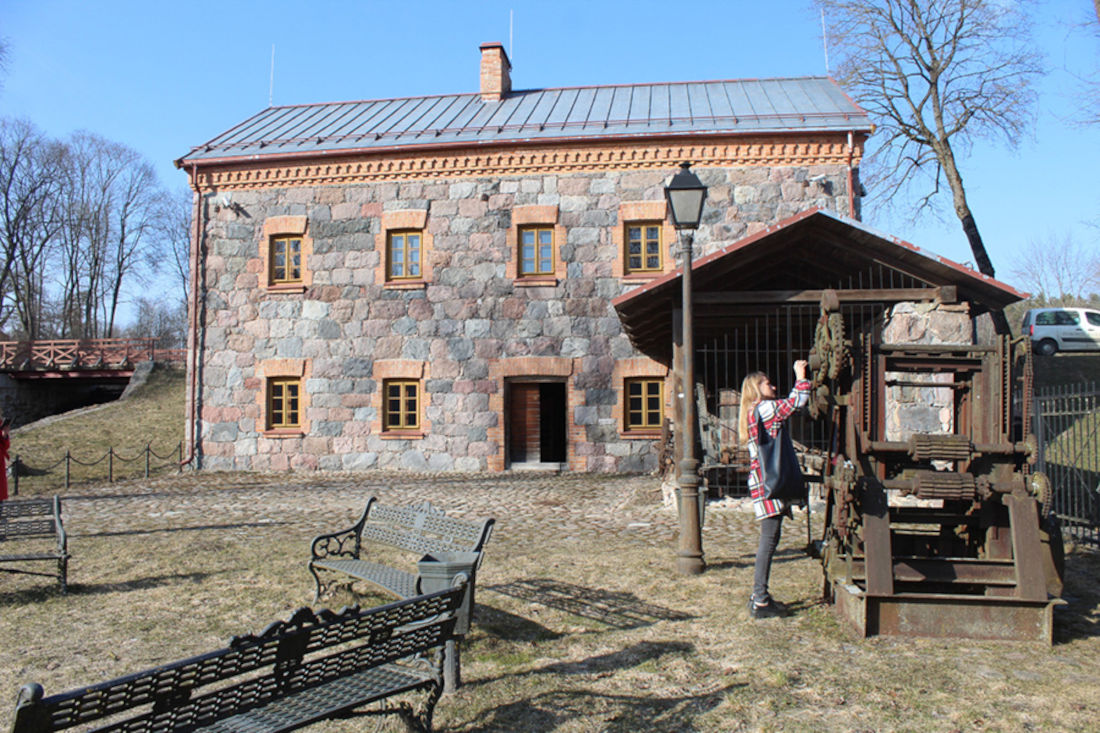
Look to the historical Liubavas water mill (20 kW)
Week 2 of HYPOSO Capacity Building Course
8 February 2022

The second week of the HYPOSO Capacity Building Course could be realized as live event in Ebolowa, Cameroon. HYPOSO project partner from Cameroon, SHW (SOLARHYDROWATT) organised the venue and accommodation for the participants from Cameroon and Uganda. HYPOSO project partner HPAU (Hydro Power Association of Uganda) organised the travel for the participants from Uganda and was in charge to support them.

The lectures covered the topics Hydraulic Units, Weirs and water intakes, Electrical equipment & lines, Operation and maintenance, and Hydropower systems. Together, the hydro colleagues from Uganda and Cameroon followed the lectures of hyposo2020 experts to refresh and/or deepen and discuss their knowledge.Together, the hydro colleagues from Uganda and Cameroon followed the lectures of hyposo2020 experts to refresh and/or deepen and discuss their knowledge. The event ended with a visit of the HPP Memve’ele which is located not too far away from Ebolowa.
HYPOSO expert Janusz Steller shares his point of view on the hydro business and informs about the HYDROFORUM conference
7 February 2022

HYPOSO:
Please tell us about the background of your organisation and your role in the HYPOSO project.
IMP PAN:
The Szewalski Institute of Fluid-Flow Machinery (IMP PAN) is a research institute of the Polish Academy of Sciences, located in Gdansk, in direct neighbourhood of Gdansk University of Technology (GUT), a Polish technical university which in 1945 overtook the premises and a part of tradition of the famous TH Danzig. The Institute evolved in 1956 from the Self-dependent Turbomachinery Establishment of the Polish Academy of Sciences. The reason was the need to provide techno-scientific support for swiftly developing ZAMECH Mechanical Workshops – the main Polish steam turbine and ship propeller manufacturer, established in the former Schichau Elbing Workshop premises in Elblag. The spiritus movens of this initiative was Professor Robert Szewalski, GUT rector and designer of the first Polish steam turbine. Later on – a multiyear director of the IMP PAN.
Since the very beginning, the GUT graduates have constituted a significant portion of the IMP PAN engineering and scientific personnel. In particular, the graduates of the former Chair of Hydraulic Turbines and Hydromechanics commenced hydropower oriented activities in the IMP PAN Department of Hydromechanics which evolved later on into Department of Dynamics of Liquids and Department of Ship Propellers and Propulsors. Over the years the IMP PAN Department of Dynamics of Liquid, headed by my father, Professor Kazimierz Steller, became the key Polish centre of hydropower research oriented on hydraulic machinery design and O&M problems, including in-depth study of such phenomena as cavitation and hydraulic transients. The significance of the Department rose especially high in 1980-ies when the Polish Government initiated major power engineering oriented research and development programmes. After slowing down and eventual stopping the large hydro projects due to economic and political crisis in the beginning of the decade, a significant portion of the hydropower R&D efforts was reoriented on small hydro. At this time, most of activities aimed at development of Polish small hydro industry were co-ordinated from Gdansk. In the meantime the first private small hydropower installations have started to emerge in the country.
The political and economic transformation in the beginning of 1990-ies and the death of Professor Kazimierz Steller in 1992 have shown a profound impact on further development of his department. After a short break the Department of Dynamics of Liquids renewed its intense commercial and scientific links with hydropower industry, but it appeared impossible to conduct rational restructuring so as to respond to changing challenges both in the industrial activity and scientific research areas. In 1998 the Department was merged again with that of Ship Propellers and 10 years later became a part of the Centre for Hydrodynamics. Today the hydropower oriented activities are continued in the Department of Hydropower Engineering headed by Professor Adam Adamkowski and the Department of Cavitation headed by Professor Alicja Krella. Both departments emerged in 2008 from the former Department of Dynamics of Liquids. After numerous transformations followed by eventual closing activities of the successors to former Chair of Hydraulic Turbines and Hydromechanics at the Gdansk University of Technology, the IMP PAN is the only Polish lab equipped with a water turbines model test rig. Most of design works are continued in the Department of Cavitation. Due to natural conditions of the country, they are generally oriented on low head applications. However, the prospects for future are not quite clear due to staff scarcity and various other internal reasons.
Currently, the Departments of Cavitation and Hydropower Engineering take part in several hydropower projects including HYPOSO. Our main role in HYPOSO is contributing to various work packages by our expertise in the field hydraulic machinery design and operation, in particular by lecturing in capacity building courses in the field of hydraulic and electric machinery operation and maintenance as well as organising relevant events. The task of our team is also to analyse the socioeconomic and environmental impact of pilot small hydropower plants planned in the target countries of Africa and Latin America.
HYPOSO:
What is your stand on the role of hydropower in Europe, especially small hydropower?
IMP PAN:
There are no doubts that climate change is the main challenge to the mankind today. As the greenhouse gases of anthropogenic origin are generally considered responsible for acceleration of the global temperature rise, the social pressure on transition to non-emission energy sources gets ever stronger. On the other hand, irrespective of the reason, climate change cannot be disputed nowadays and we have to adapt to such phenomena as ever more severe droughts and increased risk of sudden and extensive floods.
Of course there are such countries like Austria, Norway or Switzerland, where hydropower contributes essentially to the energy mix. However, even in such countries as Poland, with hydropower contributing only by ca. 1.3 % to the mix, hydropower significance should rise immensely in the next decades in view of the need to provide the necessary energy storage and regulatory power capacities - both so important for the power system ever more intensely penetrated by the unstable renewable energy sources. The ancillary power system services are provided mainly by storage and pumped storage plants, sometimes also by river cascades run in the swell operation mode. The classic storage plants use generally multipurpose reservoirs which are of course of essential significance also for water management needs. As users or owners of dams and reservoirs the hydroelectric plants generally contribute to the erection and maintenance costs of the hydraulic civil works.
The mini and small hydropower plants (with power capacity between several hundred kW and 10 MW) can play the same role as large ones, but at the much smaller scale. Especially, as in view of swiftly rising number of unstable micro-installations the demand for local power balancing (also within the so called energy clusters) becomes ever more significant. The additional benefits include improving grid parameters at the national grid outskirts and lowering the energy losses in the distribution lines.
Except some islands, isle grids are not so frequent in Europe. Even in such case SHPs are usually not the only source of electricity if at all. However, it is important that some storage SHPs (including PSSHP) can take over important regulation duties in case of small isle grids or portions of major grids (e.g. within a cluster) disconnected from the main part due to an emergency situation.
Of course, SHPs are of paramount significance for the water management sector as well. The main benefit is care or at least partial financing O&M costs of dams and multipurpose reservoirs by SHPs owners. Due to large number of small hydro installations, the SHPs may this contribute significantly to improving water hydrological conditions at large territories, but also avoiding some local floods.
HYPOSO:
With regards to your role in HYPOSO, what do you expect to achieve in the target countries?
IMP PAN:
HYPOSO is generally expected to be beneficial both to the small hydropower sector in the target countries and the small hydropower industry within the EU. I strongly believe that spreading information on European industry experience and capabilities will be really helpful for our partners. As a Polish citizen I hope also that the IMP PAN activity will help Polish manufacturers and developers to access new markets.
HYPOSO:
You are also the organizer of the HYDROFORUM congress. Can you tell us a little bit about this event?
IMP PAN:
HYDROFORUM 2021 was already the 10th event in the series of Polish Hydropower Conferences, organised annually ever since 2011. However, the history of HYDROFORUM is much longer as the first conference under this name was held already in 1973, 2 years af-ter commissioning the Żydowo pumped storage power plant in Pomerania region of Poland. The original HYDROFORUM Conferences were organised every 4 to7 years and dealt with various problems of hydraulic turbomachines, especially those encountered in power industry. The main organiser was Department of Dynamics of Liquids of the Szewalski Institute of Fluid-Flow Machinery. Due to the IMP PAN industrial connections, hydropower was always in the focus of the debate and hydropower companies were usually the main partners of the events. An important component of the event was always a study visit to a new or newly refurbished installation. Right from the beginning the conferences were addressed to representatives of industry, research and development institutions and universities. Initially, the delegates came from Poland, some East European countries and East Germany. Sometimes these were Poles living in the West European countries. The conference contributions were delivered in Polish, English, German and Russian. It was only in 2000 that a bilingual Polish/English formula was adopted and the simultaneous interpretation was introduced. Even without this step, the conferences gained swiftly good opinion due to their technical level, interesting debate and study tours. The last two conferences in this series were held in 2000 and 2005 in Czorsztyn Tourist Village (Podhale Region) and Kliczków Castle (Lower Silesia Region), respectively. In both cases - with strong support of the Polish Hydropower Association.
The series of Polish Hydropower Conferences was initiated in 2011 by the so called Validation Workshop of the SHP STREAMMAP project. The workshop and the conference accompanied the annual RENEXPO Poland event in Warsaw. It is worthwhile to mention that SHP STREAMMAP was one of the last EU projects co-ordinated by the European Small Hy-dropower Association (ESHA). The RENEXPO Poland naming was used for our conferences until 2017 when REECO Group withdrew eventually from their engagement in our country. Throughout all this time the main organisers were the Szewalski Institute of Fluid-Flow Machinery, the Polish Hydropower Association and the Polish Association for Small Hydropower Development.
In 2018 the old name and logo of HYDROFORUM were adopted. In their current formula the HYDROFORUM events represent first of all a platform for discussing challenges encountered by the hydropower sector in Poland and in Europe in view of changes in its legal & administrative constraints, but also capabilities resulting from the available potential, technology and environmental requirements. On the other hand the conferences serve exchange of opinions and information on the prospects and observed trends in sector development, experience on erection and operation of hydropower installations, new solutions to technical problems and the results of R&D efforts. Since 2017 the conferences are organised at various sites in Poland and always connected with a study visit to a hydropower plant of some special technical value.
The HYDROFORUM 2021 conference was initially planned to take place in the Szewalski Institute of Fluid-Flow Machinery. However, due to space scarcity and very high interest of potential delegates the venue was moved to the historical Main Hall of Gdansk University of Technology. Eventually, the Conference debate took place on October 13th and 14th and was attended by 130 delegates who presented 36 contributions - including the introductory lectures on HYDROFORUM background and history, as well as on the person of Mikhail Dolivo-Dobrovolsky on the 100th anniversary of the first long distance transmission of the 3-phase current from a hydroelectric power plant. The last lecture was delivered by Dr Piotr Szymczak, president of the Polish Association of Electrical Engineers who also presented some honorary medals to several eminent Polish hydropower engineers and scientists. The topic of the traditional HYDROFORUM Debate was Hydropower in the energy transition and the policy of mitigating the climate change effects in Poland and within the region. The panellists included representatives of some significant Polish companies and renowned experts from Poland and other European countries. The other panel debate was organised by the NORWEP (Norwegian Energy Partners) foundation and concerned a hot topic of hybrid power plants – especially hydropower plants with a floating photovoltaic component.
The conference took place only 2 days after HYPOSO interim meeting which took place on October 11th in the Grano Hotel, in direct neighbourhood of the historical centre of Gdansk. The HYPOSO presence provided a good opportunity to include a brief project session in the conference programme. The session was chaired by Prof. Bernhard Pelikan and the contributions delivered dealt with the HYPOSO promotion/matchmaking platform for the EU SHP industry (I. Ball, D. Rutz) and GIS techniques as applied for planning small hydro projects in remote areas (P. Punys, G. Vyčienė, L. Jurevičius, A. Balčiūnas). The day between the HYPOSO meeting and the HYDROFORUM Conference was used for a study visit in the nearby Żarnowiec Pumped Storage Power Plant (the largest Polish hydropower plant), an afternoon walk through the Gdansk historical centre and the reception of the Polish Hydropower Association. A study visit to Żarnowiec Pumped Storage Power Plant ended also the whole HYDROFORUM 2021 conference on October 15th.
HYDROFORUM 2021 is generally considered a greater success in the sequence of Polish Hydropower Conferences. The book of abstracts, all presentations and numerous photographs are available from the Polish Hydropower Association (Towarzystwo Elektrowni Wodnych) website. Numerous papers based on conference contributions are already being published in the Energetyka Wodna quarterly. The authors of selected contributions will be invited to submit their papers to the special issue of Transactions of the Institute of Fluid-Flow Machinery. The next year event is planned to take place in Warsaw and to be linked with a visit to Dębe Hydropower Plant (now under refurbishment).
HYPOSO:
If you could wish one thing for the hydropower sector, what would it be?
IMP PAN:
Thank you for this question. Providing a reasonable answer is not so easy if only one thing is to be selected. My response may astonish you, but after some consideration I find that proper education of the younger generation is the most needed factor. Of course, education is important in various fields of human activity, as it enables sustainable progress of our civilisation with due respect to the natural environment. Some people may consider this way of thinking naïve, but I do strongly believe that proper education and easy access to the knowledge are the best vaccines against political manipulation, prejudices, social and even national conflicts. The reflection on education impact on sustainable growth of our economy refers in particular to hydropower which is not mentioned among renewables in Polish primary school textbooks. Numerous Polish secondary school students do benefit of only one hour of physics a week – much, much less than me over half a century ago, under the Communist regime in Poland. These young people can go now to the streets and require politicians to do something against the climate change, but with their poor education they will have immense problems to do anything by themselves after having grown up. Further on, they can get easily manipulated by the green NGOs demanding removal of dams while forgetting that biodiversity will extinct if there is no water in the rivers and requiring development of emission-free electricity sources while forgetting about hydropower necessary for large scale energy storage and grid ancillary services.
Having said the above, I think there is one factor of even more fundamental significance – a sincere good will and true long term commitment of decision-makers to cope with the main challenges of our civilization. For this purpose the strategic thinking should never be replaced by the wishful one or that oriented merely on the next parliamentary elections. Advertising new renewable energy technologies and public actions for environmental protection may be highly welcome, but they should never replace high quality education based on solid grounds of natural and technical sciences.
The beginning of the year 2022 is a good opportunity to wish all the readers of this newsletter a real progress in this direction, a really good will to be found among people in their surroundings, success in pursuing their goals, happiness and prosperity in their personal life. And of course, good health - without SARS Covid-19!
FIThydro – Fishfriendly Innovative Technologies for Hydropower
7 February 2022
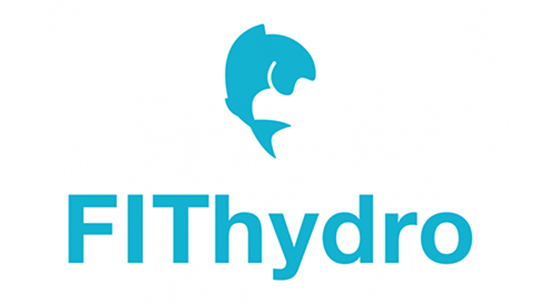
Peter Rutschmann (FIThydro Coordinator)
Hany Abo El Wafa (FIThydro Project Manager)
Technical University of Munich
Introduction
FIThydro, Fishfriendly Innovative Technologies for Hydropower, was a European Commission-funded Horizon 2020 project with 26 partners from 10 European countries and a total budget of 7.2 million Euros. The project, led by the Chair of Hydraulic Engineering at the Technical University of Munich, highlighted the important role of hydropower as a renewable, CO2 free energy in Europe. FIThydro addressed the decision support in commissioning and operating hydropower plants (HPP) by use of existing and innovative technologies. It concentrated on mitigation measures and strategies to develop cost-efficient environmental solutions and on strategies to avoid individual fish damage while enhancing population developments. Therefore, HPPs all over Europe were involved as test sites.
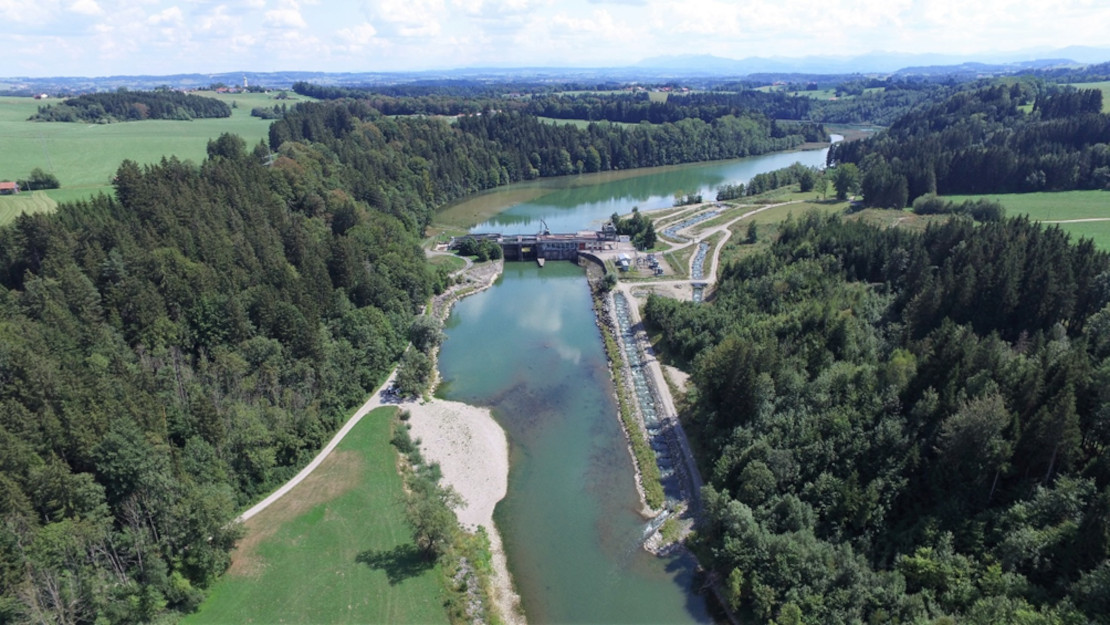
Figure 1: FIThydro Test case – Altusried Hydropower Plant, Germany (© Oliver_König)
The most important outcomes of the project are briefly explained below:
Decision Support System - DSS (Lead: the University of Hull, UK): The FIThydro DSS ( www.dss.fithydro.wb.bgu.tum.de/home/ui ) is a systematic, risk-based, open-access online assessment tool to guide users to environmentally (fish-)friendly hydropower production and safe fish passage, through the planning, development and operation of existing and new hydropower schemes, including the revision of permits [2].
FIThydro Wiki (Lead: Sintef Energy Research, Norway): The FIThydro Wiki ( www.fithydro.wiki/index.php/Main_Page ) is an open access online platform that provides an overview of and information on different mitigation measures in the context of fish friendly hydropower. The mitigation measures are classified according to various parameters. Each measure has a suggested procedure with recommended methods, tools and devices for different stages of implementation. The FIThydro Wiki is closely linked to the DSS [3].
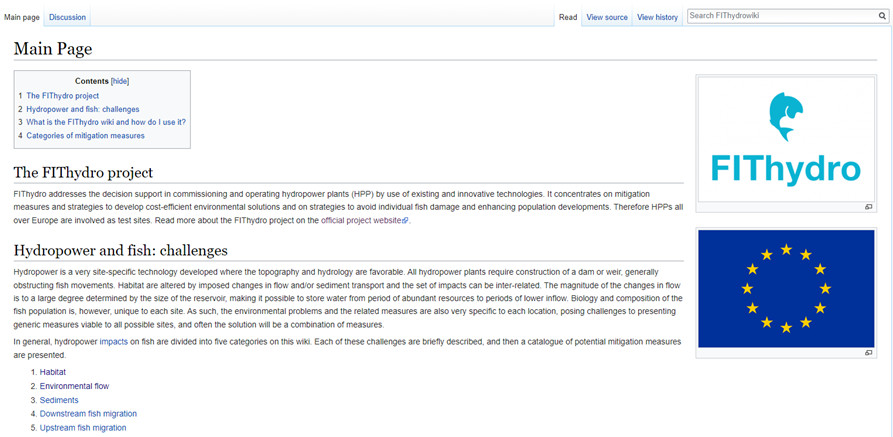
Figure 2: FIThydro Wiki
European Fish Hazard Index-EFHI (Lead: The Leibniz-Institute of Freshwater Ecology and Inland Fisheries, Germany): The EFHI is a referenced, index-based assessment scheme for fish hazards at hydropower environments. Beyond the pure impact assessment, this index species-specifically guides the derivation and improvement of target fish populations in hydropower environments. The EFHI is the first European-wide guidance and assessment tool for ensuring more environmentally and especially fish-friendly hydropower production [4].
Cumulative Impact Assessment - CIA tool (Lead: University of Hull, UK): The CIA tool is an evidence-based guidance on the assessment of environmental impacts from multiple HPP schemes in a single river basin. The model is based on fish life history strategies and provides a GIS-based tool that can model potential basin scale impacts and support informed decision-making on siting HPP schemes and mitigation planning.
Furthermore, a set of devices and computational tools have been developed to protect individual fish and to enhance upstream and downstream migration of fish. These are:
- Curved-bar Racks - CBR (Lead: ETH Zurich, Switzerland): The CBR is a fish guidance structures which consist of vertical curved bars with an adjacent open channel bypass system. The bar spacing of the CBR is large and therefore no rack cleaning is necessary and hydraulic losses are negligible. CBR proofed in Lab tests as more efficient than fine racks. CBR addresses the fish behavior in that fish try to avoid the vortex shedding produced by it [5].
- Induced Drift Application - IDA (Lead: Technical University of Munich, Germany): The IDA is a fish protection system to reduce mortality during turbine passage by using electro stimuli just upstream of the turbine runner. It directs fishes to the turbine hub and slightly paralyzes them by electro shocks. The device requires only simple and quick installation, is cost-efficient and can be used in new and for retrofitting at existing also large-scale HPPs.
- Barotrauma Detection System - BDS (Lead: Tallinn University of Technology, Estonia): The BDS is used in connection with fish damage in turbines and is characterised by a watertight autonomous measuring device that records pressures, velocities as well as accelerations during a turbine passage. From the recordings, the probability of fish damage in the turbine can be derived.
- Artificial Lateral Line Probe - LLP (Lead: Tallinn University of Technology, Estonia): The LLP mimics the lateral line organ of a fish and the perception by the fish's natural sensors. With the LLP, left-right and front-rear flow field changes can be recorded and evaluated with artificial intelligence.
- 3D Sensorless Optical (Lead: ETH Zurich, Switzerland): and Ultrasonic fish-tracking (Lead: Technical University of Munich, Germany) systems: The optical 3D fish-tracking system has been developed for etho-hydraulic live-fish tests in the Lab. Vertically submerged cameras and a MAT- LAB-based 3D tracking software allow to determine fish locations from recorded videos. The ultrasonic tracking can be applied for 3D fish-tracking as well as adaptive and dynamic migration management of fish. It works without tagging of fish and detects fish in natural rivers with high spatial and temporal resolution over long ranges using multiple ultrasonic transmitters.
- Agend based model in CASIMIR (Lead: SJE Ecohydraulic Engineering, Germany): The well-established fish habitat model CASIMIR was enhanced during the FIThydro project with an Agent Based module. The module mimics the fish behavior during search for upstream migration at hydropower plants. It uses so-called behavioral rules, which resulted from a long-term 2D telemetry study. Some 6 million positions of the tagged fishes were recorded and analyzed.
- CFD based turbine fish mortality modelling using BioPA (Lead: Voith Hydro, Germany): BioPA is an existing fish passage modelling tool developed by PNNL in the US. In FIThydro the biological dose response for European species was collected and is now available for BioPA. Additionally, the model was extended to consider for active fish behavior during turbine passage. Consequently, fish passage hill-charts can be used to adapt turbine operation to fish migration cycles.
Current status
The FIThydro project has ended on 30 April 2021, All project objectives were successfully achieved by bringing together partners from different disciplines and enabled further developments in the field of sustainable hydropower and fish protection. The project has gathered a lot of knowledge and made it available to a wider community. In addition, new tools and innovative devices have been created and developed and are ready for use. A complete overview of the results is available at the FIThydro website https://www.fithydro.eu/ and on the EC Cordis page ( https://cordis.europa.eu/project/id/727830 ).
FIThydro impact in HYPOSO countries
FIThydro focuses on mitigating the impacts of hydropower on fish populations and ecology, while HYPOSO aims to promote hydropower as a low-cost, CO2-free and sustainable power generation in emerging economies. While the cost price of hydropower is compelling and has often led to economic growth, its environmental impacts have often been neglected in the past and seen as cost drivers. FIThydro has sought to implement sustainability in a cost-effective way, or even to achieve win-win situations to improve production and reduce environmental impacts. Thus, it was possible to demonstrate: Considering sustainable environmental protection does not necessarily have to have economic disadvantages! With FIThydro, solutions are presented that are both cost-efficient and environmentally friendly, as well as bringing macroeconomic and longer-term economic benefits, and are thus also interesting for the HYPOSO countries. Tools such as the FIThydro-DSS or the FIThydro-Wiki make it possible to optimise hydropower at given locations in this respect and to find the best solutions even in the absence of experience in ecological hydropower generation. The FIThydro project can therefore also provide important impulses in the HYPOSO countries!
 |
The FIThydro project has received funding from the European Union’s Horizon 2020 research and innovation programme under grant agreement No 727830. |
First HYPOSO Workshop on Framework Conditions held in Cameroon
31 January 2022
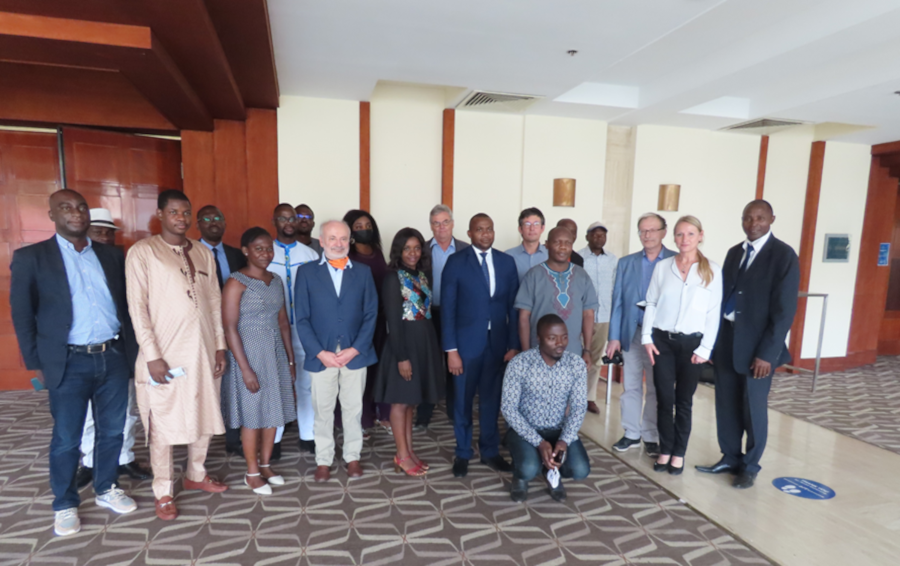
The first (of five) HYPOSO Workshop on Framework Conditions was held on 28 January 2022 in Yaoundé, the capital of Cameroon. It was organised by the project partners TRMEW (Poland) and SHW (Cameroon). Mr Valerie Nkue, the representative of the Ministry of Water Resources and Energy of Cameroon, opened the event and welcomed the guests, and after that Ewa Malicka, President of the Polish Small Hydro Association, presented the information on the HYPOSO project as well as the objectives of the workshop. She was supported by Joseph Kenfack (SHW), our project partner from Cameroon who managed to achieve the support of the Minister of Water Resources and Energy of Cameroon, who signed and stamped invitations to important stakeholders to support the HYPOSO project. After the introduction, Joseph Kenfack presented the outcomes of the analysis of the framework conditions for hydropower in Cameroon made within the project by a Lithuanian partner - VDU. Subsequently, Nino Frosio (FN) presented the three selected pilot sites, visited by the project experts in recent days. He pointed out the potential barriers these projects can encounter while being developed.
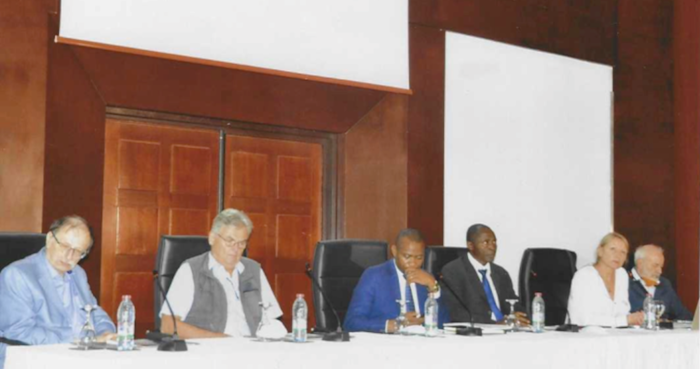
After this, the most important part of the workshop came, i.e. the discussion, moderated by prof. Bernhard Pelikan (FN) together with Joseph Kenfack, on the actual situation and needs for hydropower in Cameroon as well as on the ideas how these needs can be met and how the development of small hydro projects can be facilitated. The views and ideas were discussed together with representatives of the Ministry of Water Resources and Energy, Investment Promotion Agency, EU Delegation, utilities as well as project developers and investors. One of the important matters indicated by the participants was the requirement to expand the pilot projects into next stages of development after the feasibility studies are completed. The main points of the discussion were then summarized by prof. Pelikan who, on these grounds, also formulated the draft recommendations for decision makers in Cameroon on how to tackle the barriers faced by small hydro developers and investors.
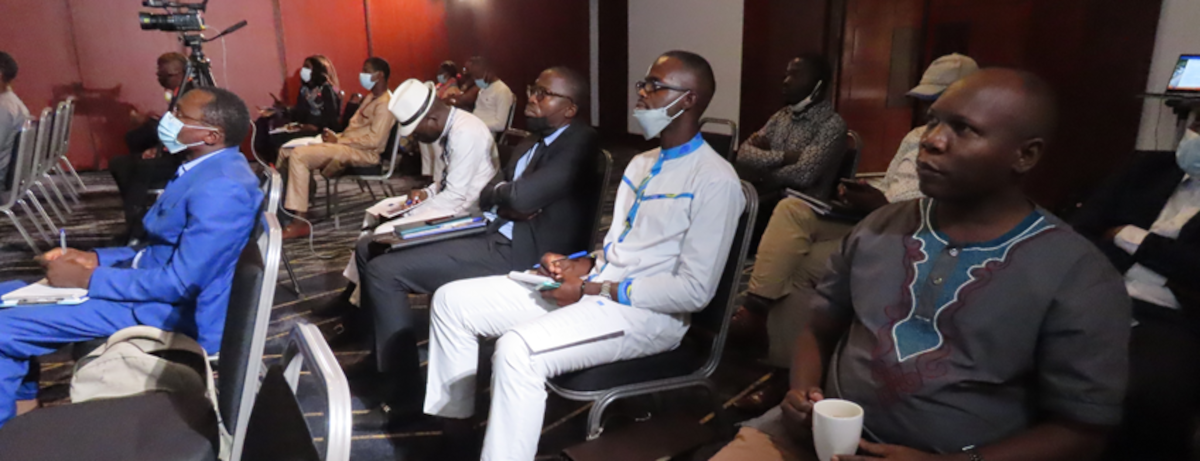
In the end of the workshop the outcomes of the HYPOSO project - the HYPOSO Map and the HYPOSO Platform - were presented to the participants as tools made to increase a number of investments in sustainable projects in target countries as well as to stimulate the market uptake of EU technologies there.

